A Conversation with Bruce Duffie
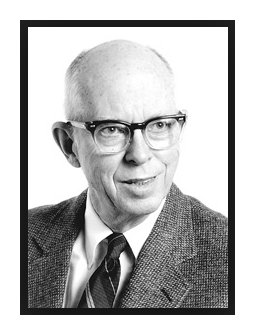

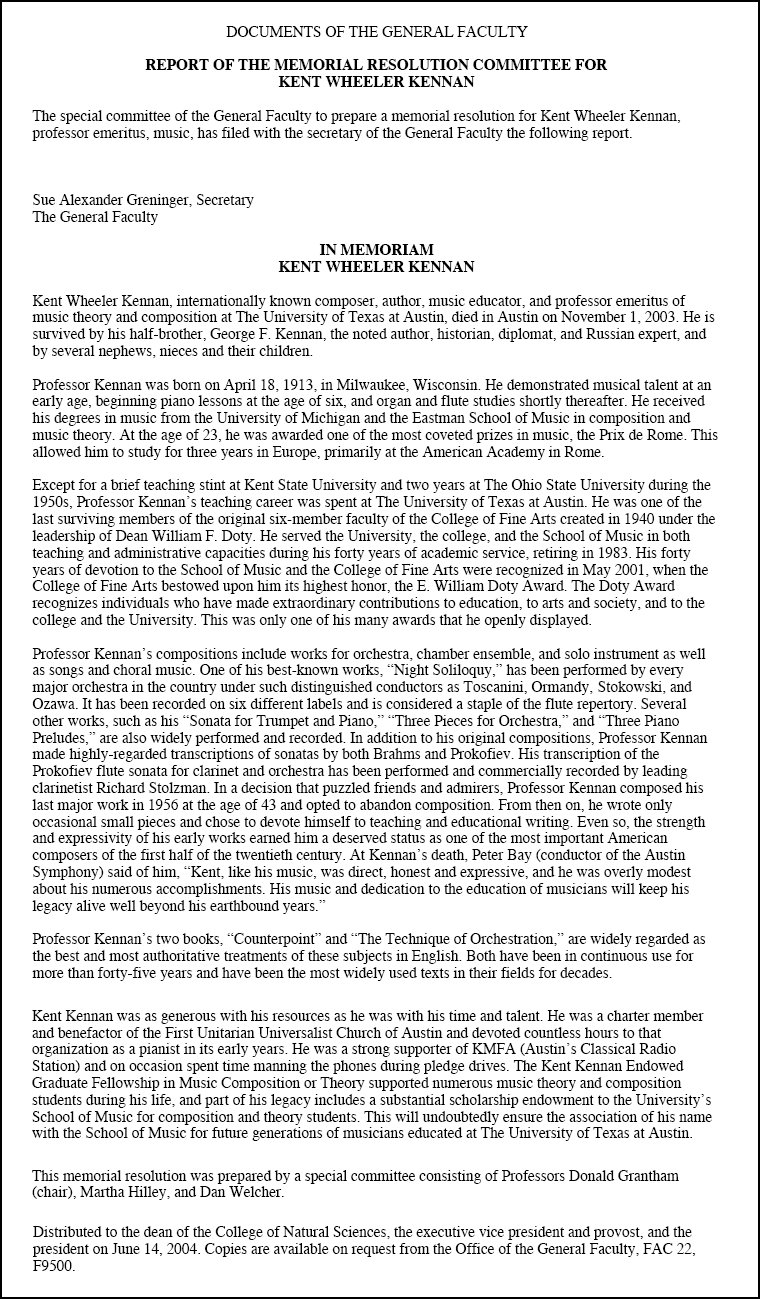
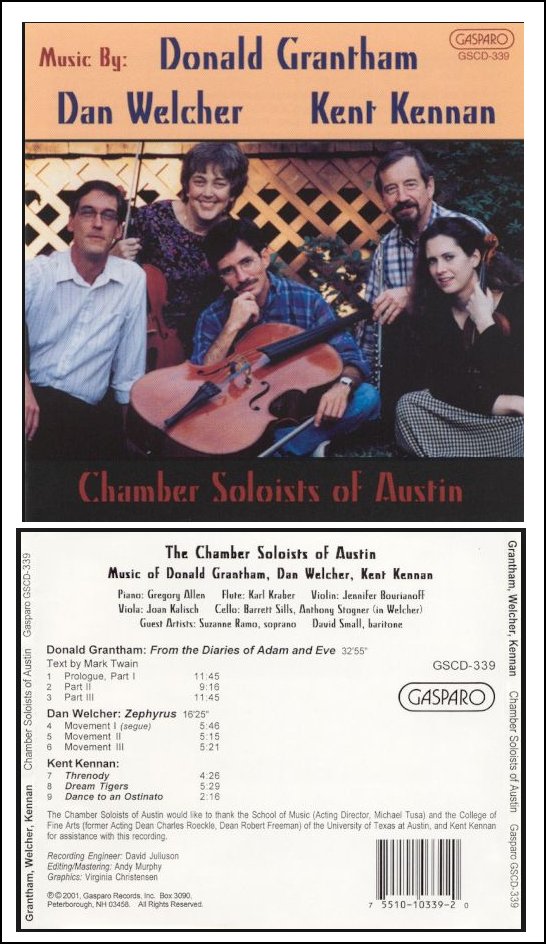 BD:
In that kind of scenario, would you encourage the expansion of the second
theme or the reduction of the fist theme, or breaking it apart into two
different compositions?
BD:
In that kind of scenario, would you encourage the expansion of the second
theme or the reduction of the fist theme, or breaking it apart into two
different compositions?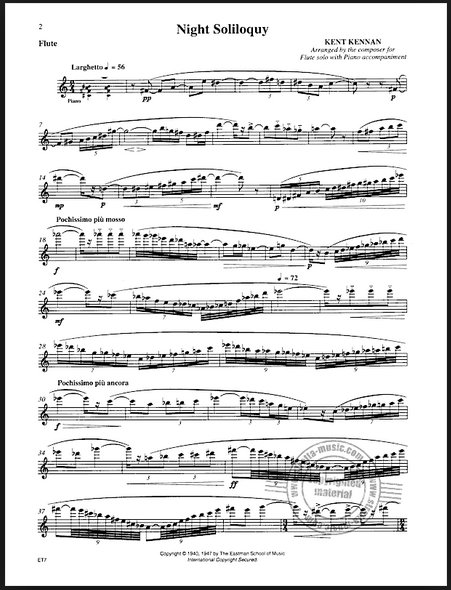 KK:
I’d like to send quotes from that to every Board of Directors of every symphony
orchestra in this country because the situation is really a vicious one,
and an unfortunate one. I don’t mean the people are vicious, but it’s
unfortunate it’s worked out that way. I’m speaking about the fact that
many Board of Directors are made up of people with the money and the influence,
but not necessarily the knowledge of music or the tolerance of new things
in art.
KK:
I’d like to send quotes from that to every Board of Directors of every symphony
orchestra in this country because the situation is really a vicious one,
and an unfortunate one. I don’t mean the people are vicious, but it’s
unfortunate it’s worked out that way. I’m speaking about the fact that
many Board of Directors are made up of people with the money and the influence,
but not necessarily the knowledge of music or the tolerance of new things
in art.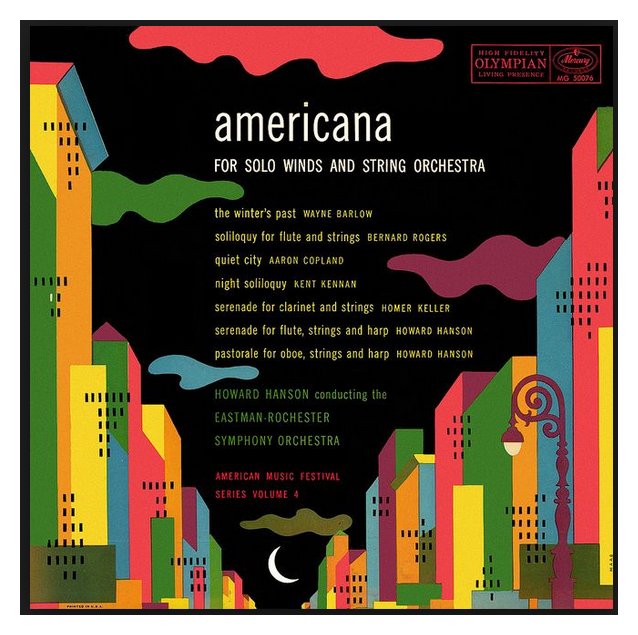 KK: I don’t know whether that’s the reason or not,
because certainly in Poland audiences seem to be very receptive to advances
in music.
KK: I don’t know whether that’s the reason or not,
because certainly in Poland audiences seem to be very receptive to advances
in music.| Founded in 1921 by State Street
businessman and bass player George Lytton as the Chicago Business Men's Orchestra, membership
was drawn from the business and professional men who worked in the downtown
area. These were not only successful businessmen but also accomplished musicians.
The Orchestra had an excellent reputation, giving local amateur players an
opportunity to perform a varied repertoire of classical music. By 1941, when
the orchestra consisted of 115 Chicagoans, 25 of its players were presidents
or vice presidents of local businesses. However, through the first twenty
years the membership included accountants, doctors, engineers, a farmer, a
postman, in fact anyone who could be chosen from the waiting list of 200 hopefuls.
Concerts were played in Orchestra Hall under the direction of such noteworthy
conductors as Frederick Stock, Rafael Kubelik, George Dasch, and Igor Stravinsky.
Soloists included such distinguished names as Percy Grainger, Mischa Mischakoff,
Louis Sudler, and William
Warfield. Eventually, the Chicago Business Men's Orchestra became known
as the Chicago Metropolitan Symphony Orchestra. The Orchestra gives amateur musicians, both men and women from all walks of life, an opportunity to perform a wide-ranging repertoire of classical music. Over the past several years, they have given accessibly priced concerts at various locations in the Chicago area, bringing music to people who would otherwise have little opportunity to enjoy live orchestral music. They have also given musicians an opportunity to appear as soloists with the Orchestra, providing valuable experience for these young artists, to the delight of both audiences and Orchestra members. Transformed into the Chicago Metropolitan Symphony Orchestra, it has grown tremendously, performing outstanding repertoire including Bartok's Concerto for Orchestra, Berlioz' Symphonie Fantastique, Strauss' Death and Transfiguration, Shostakovich's Symphony No. 5, and Mahler's Symphony No. 1. The CMSO has performed with soloists from the Lyric Opera of Chicago Orchestra and Chorus, and the Chicago Symphony Orchestra. Additionally, the audience has dramatically increased and enjoys accessibly priced concerts at the modern and elegant Gottlieb Concert Hall in the Joy Faith Knapp Music Center, located in the West Loop/Greektown neighborhood of Chicago. In 2001, Mayor Richard M. Daley proclaimed an entire day to honor
this orchestra. Under the direction of award-winning Music Director and
Conductor, Russell Vinick, the Chicago Metropolitan Symphony Orchestra celebrates
95 years of outstanding programs for the Chicago community! |
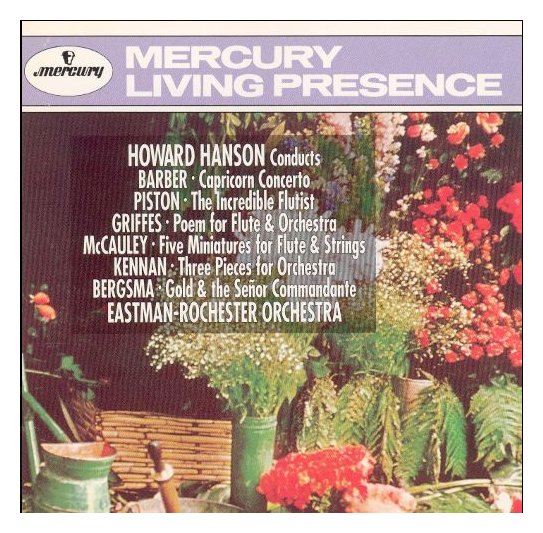 BD: When an orchestra is doing one of your pieces,
are you the kind that lets the conductor get on with his work, or do you
stand over him and make suggestions all the time?
BD: When an orchestra is doing one of your pieces,
are you the kind that lets the conductor get on with his work, or do you
stand over him and make suggestions all the time?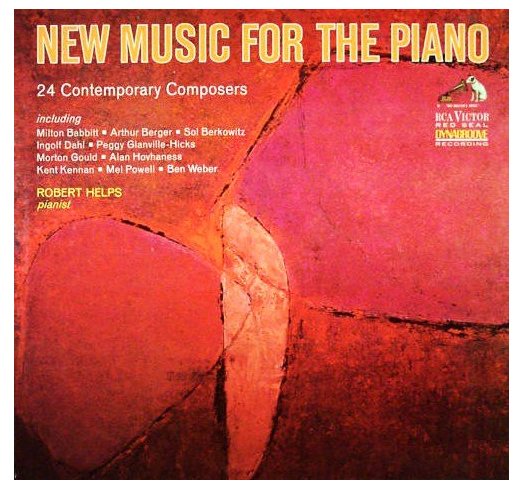
|
Robert
Helps in a 20th Century compendium "New Music for the Piano: 24 Contemporary
Composers," Ingolf Dahl's Fanfares
(1958), Arthur Berger's
Two Episodes (1933), Kent Kennan's
Two Preludes (1951), Samuel Adler's Capriccio (1954), Hall Overton's
Polarities No. 1 (1958), Milton Babbit's
Partitions (1957), Miriam Gideon's Piano Suite No. 3 (1951), Sol Berkowitz's
Syncopations (1958), Ben
Weber's Humoreske op. 49
(1958), Leo Kraft's
Allegro Giocoso (1957), Paul A. Pisk's Nocturnal Interlude (undated), Mel Powell's Etude (1957), Morton Gould's Rag-Blues-Rag (undated), Vivian Fine's Sinfonia and Fugato (undated), Alan Hovhaness' Allegro on a Pakistan Little Tune op. 104 No.
6 (1952), George
Perle's Six Preludes op. 20B
(1946), Norman Cazden's Sonata op. 53
No.3 (1950), Joseph Prostakoff's Two Bagatelles (undated), Ernst Bacon's The Pig Town Fling (undated), Helps's
Image (1957), Mark Brunswick's
Six Bagatelles (1958), Earl Kim's Two Bagatelles (1950/1948), and Josef Alexander's Incantation (1964). Underwritten by The
Abbey Whiteside Foundation. Cover art is by Sid Maurer. Glossy full-size 10-page
booklet with extensive notes on all composers and works featured herein,
written by Joseph Prostakoff. The RCA LP was originally issued in 1966, and later re-issued on CRI in 1971. When it was re-mastered and issued on a CRI CD in 2001, the works by Berger, Kraft, and Fine were omitted. |
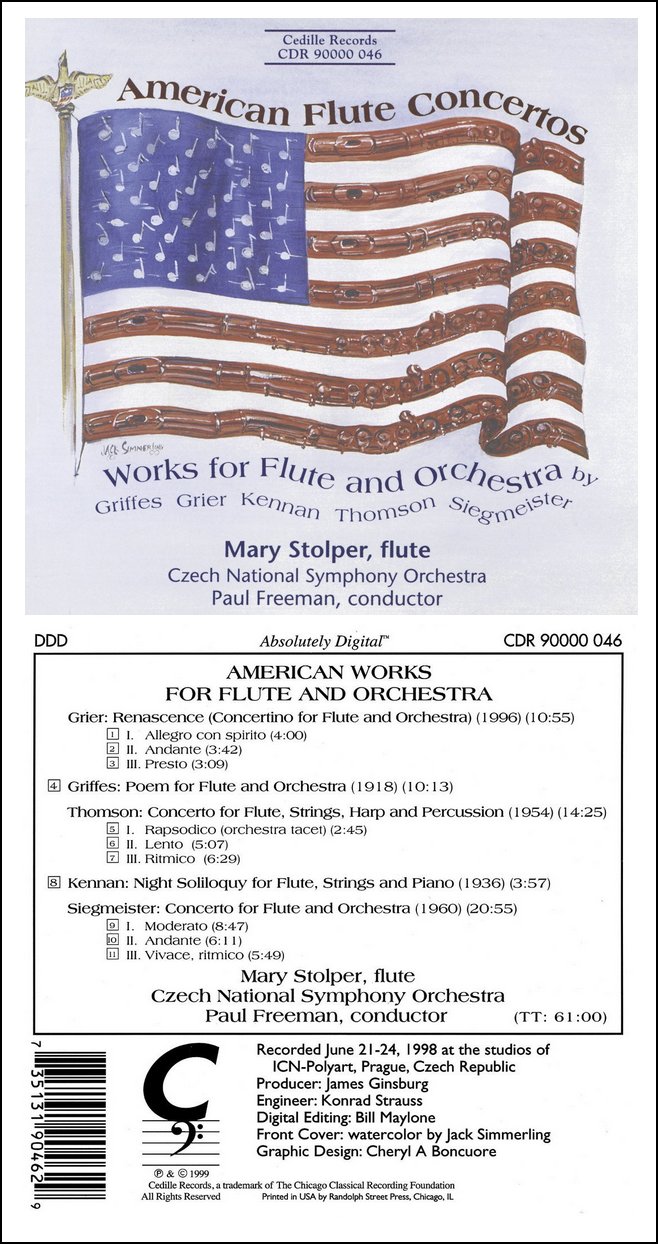 KK:
I wonder about that. I hate to dampen the fires in any case, but it
certainly seems that there are more good composers around than there is
opportunities for them to be heard. I personally would find it a little
hard to encourage young composers today without making the situation crystal
clear to them — that they mustn’t expect the world
to be waiting for them when they get out of school. I think what happens
a lot of times is that the young composer equates encouragement by his teacher
with future success in the world, whatever that means. I don’t think
it’s quite true what it means. What he thinks is that the New York
Philharmonic will be waiting to play his music, and the world will acclaim
him, and unfortunately it isn’t that way most of the time. But, on
the other hand, you don’t want to be too pessimistic with the young composer
because maybe he will set the world on fire! It’s just that chance,
and you owe it to him to give him the opportunity. [Again, turning
the tables] What do you think? Do think there are too many composers
around for the chances they have to get their music played?
KK:
I wonder about that. I hate to dampen the fires in any case, but it
certainly seems that there are more good composers around than there is
opportunities for them to be heard. I personally would find it a little
hard to encourage young composers today without making the situation crystal
clear to them — that they mustn’t expect the world
to be waiting for them when they get out of school. I think what happens
a lot of times is that the young composer equates encouragement by his teacher
with future success in the world, whatever that means. I don’t think
it’s quite true what it means. What he thinks is that the New York
Philharmonic will be waiting to play his music, and the world will acclaim
him, and unfortunately it isn’t that way most of the time. But, on
the other hand, you don’t want to be too pessimistic with the young composer
because maybe he will set the world on fire! It’s just that chance,
and you owe it to him to give him the opportunity. [Again, turning
the tables] What do you think? Do think there are too many composers
around for the chances they have to get their music played?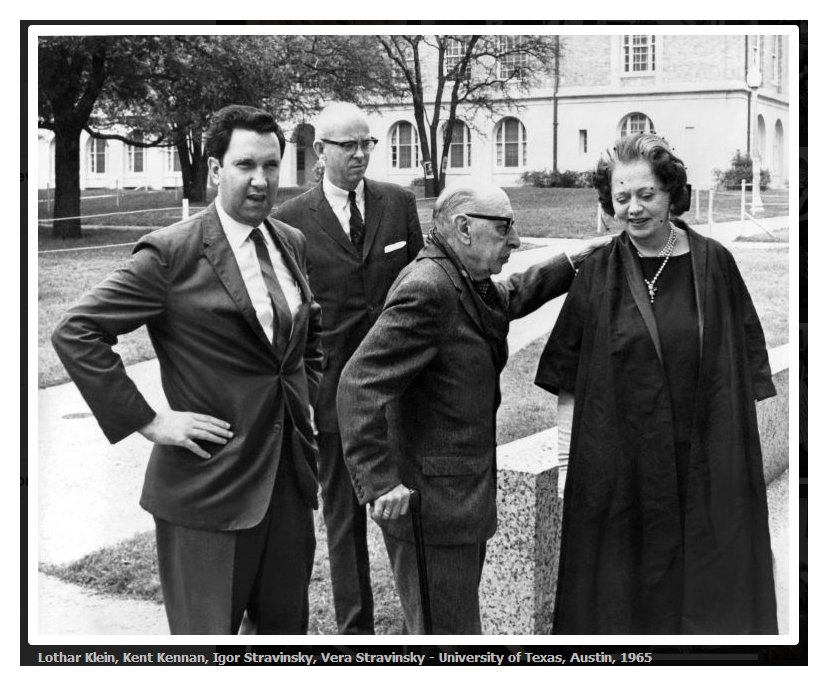
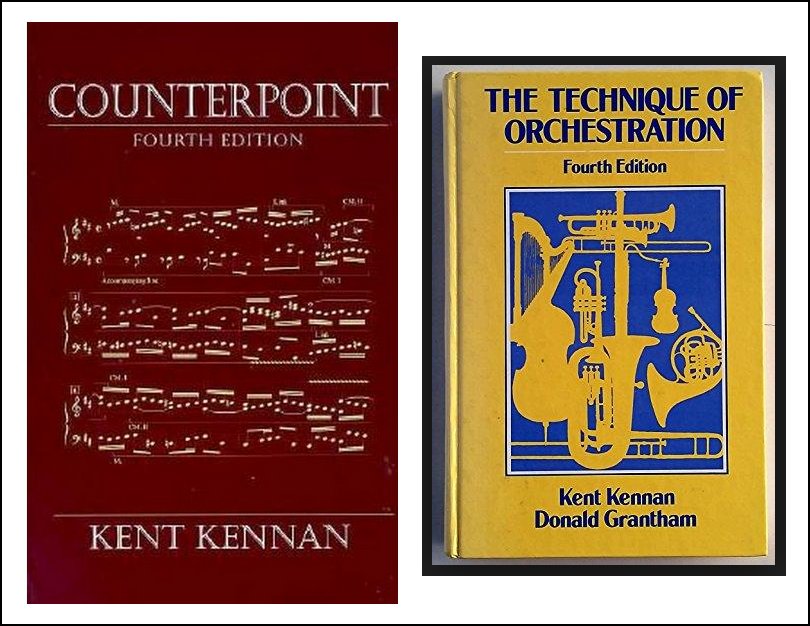
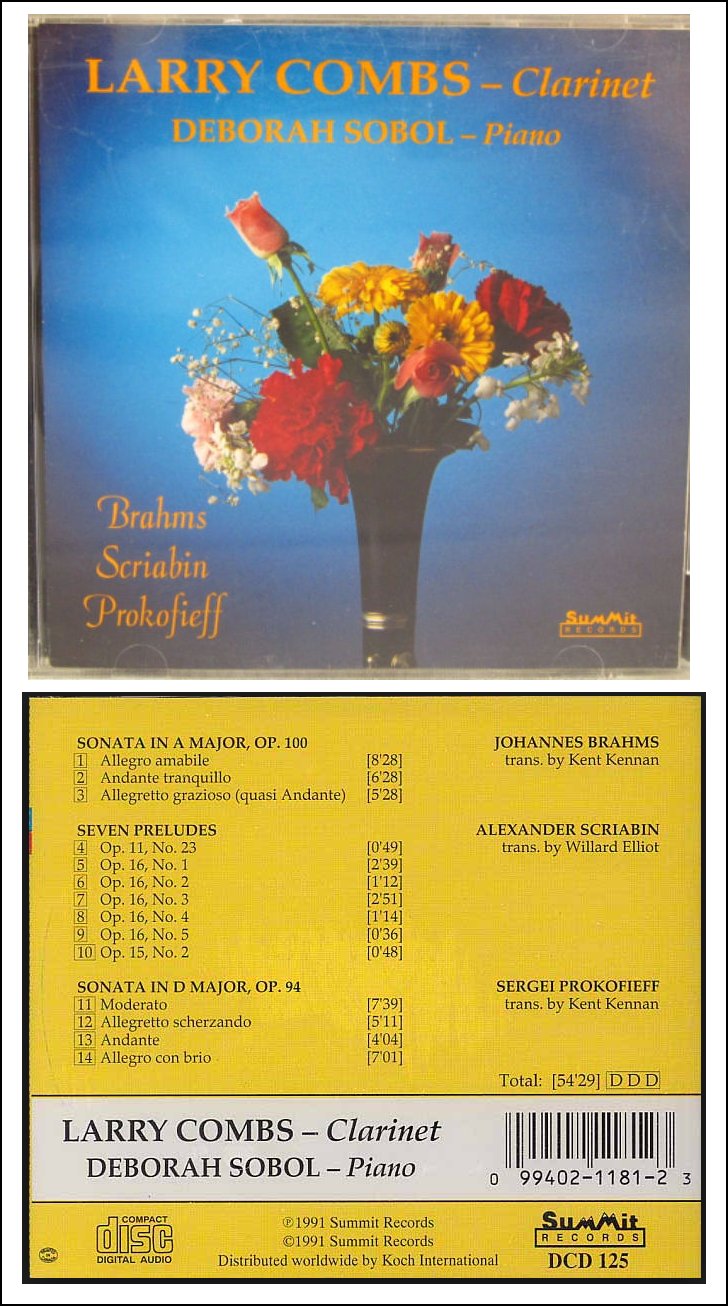

|
Richard Bales
(Composer, Arranger)
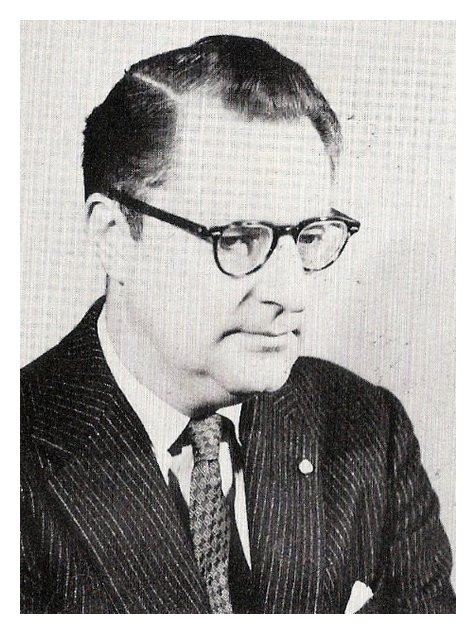 Born: February 3, 1915 - Alexandria, Virginia, USA
Born: February 3, 1915 - Alexandria, Virginia, USADied: June 25, 1998 - Lake Ridge, Virginia, USA The American conductor and composer; Richard (Henry Horner) Bales, attended Episcopal High School in Alexandria, and then went on to study music at the Eastman School of Music in Rochester, New York (Mus.B., 1936), at the ]uilliard Graduate School in New York (1938-1941), and conducting under Serge Koussevitzky at the Berkshire Music Center in Tanglewood (summer, 1940). In 1935 Richard Bales made his conducting debut with the National Symphony Orchestra in Washington, D.C.. He was then was conductor of the Virginia-North Carolina Symphony Orchestra (1936-1938). In 1942 he became the first music director of the National Gallery of Art in Washington, D.C., and in 1943 founded the National Gallery Orchestra. He organized, promoted and presented Sunday concerts for more than four decades. He retired from the National Gallery in the summer of 1985 after 42 years as assistant director for music. In that period, he was responsible for 1,786 free concerts in the museum's Garden Courts, and he raised the National Gallery Orchestra from a fledgling ensemble to a level of musical eminence. He was a prominent figure in the Washington area for over fifty years. He also was music director of the Washington, D.C., Cathedral Choral Society (1945-1946). In 1960 he received the Alice M. Ditson Award. During his long tenure at the National Gallery of Art, he introduced numerous works by American composers, both old and new. Richard Bales was also very well known for his compositions of music relating to the American Revolution and the Civil War. The most well known are The Confederacy, The Union, and The Republic. The latter has been performed at every presidential inauguration since 1955. He composed over 35 pieces, been a guest conductor for many of the nation's best orchestras, performed for presidents and foreign heads of state and received numerous honors and awards. 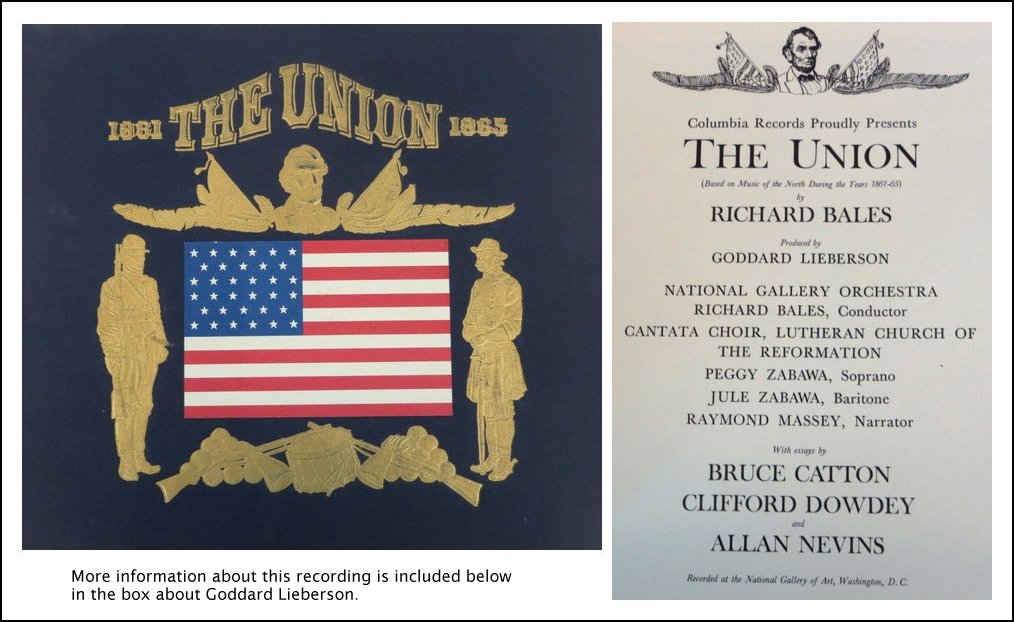
|
Mitch Miller
For over 15 years, beginning in 1948 and lasting into the early '60s, Mitch Miller was a major force in the recording industry. He was not only one of the most powerful men in the music business for much of that time, as the head of A&R (artists and repertory) for the pop division at Columbia Records, but he was also one of that label's most popular recording artists in his own right, responsible for dozens of chart singles and a string of top-selling LPs, and also hosted his own top-rated prime-time network television music show. And that pop music career followed a decade and a half as a successful working classical musician. 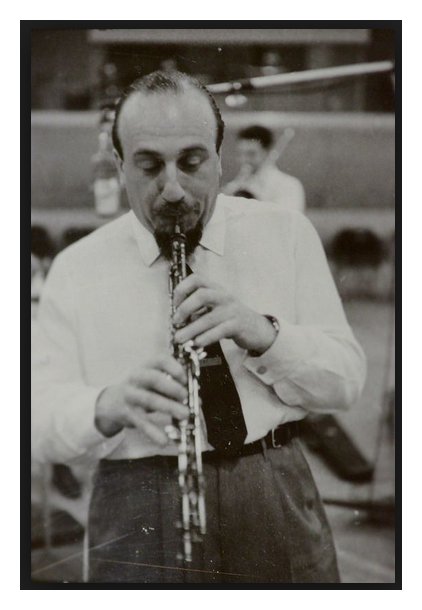 Mitchell William Miller was born in Rochester, NY, on the Fourth of July,
in 1911. He showed his interest in music very early in life -- at six he
began learning the piano and at 12 he took up the oboe. He attended the prestigious
Eastman School of Music, where he made the acquaintance of a fellow student,
Goddard Lieberson, who was to become a major figure in the music business
two decades later. Miller graduated in 1932, and joined the music department
at the Columbia Broadcasting System (CBS) radio network that same year,
as an oboist and English horn player. At that time, CBS had no record label,
and Miller worked as a member and sometime soloist with the CBS Symphony.
Among his many jobs with the orchestra, he was one of the musicians playing
the musical accompaniment on the night of Orson Welles' infamous War of the Worlds radio broadcast. He
also did a fair amount of session work during those years, including a recording
of Jean Sibelius' Swan of Tuonela
with the Philadelphia Orchestra under Leopold Stokowski, on RCA Victor.
When the network acquired the American Record Company in 1939 -- which it
renamed Columbia Records -- Miller appeared as an oboist on recordings conducted
by light classical/pop leader Andre Kostelanetz, and also worked with groups
such as the Budapest String Quartet. He was featured on the earliest recordings
of the music of composer Alec Wilder, who was a good friend of Miller's.
And he was later the soloist on a Columbia Masterworks release of the Mozart
Oboe Concerto.
Mitchell William Miller was born in Rochester, NY, on the Fourth of July,
in 1911. He showed his interest in music very early in life -- at six he
began learning the piano and at 12 he took up the oboe. He attended the prestigious
Eastman School of Music, where he made the acquaintance of a fellow student,
Goddard Lieberson, who was to become a major figure in the music business
two decades later. Miller graduated in 1932, and joined the music department
at the Columbia Broadcasting System (CBS) radio network that same year,
as an oboist and English horn player. At that time, CBS had no record label,
and Miller worked as a member and sometime soloist with the CBS Symphony.
Among his many jobs with the orchestra, he was one of the musicians playing
the musical accompaniment on the night of Orson Welles' infamous War of the Worlds radio broadcast. He
also did a fair amount of session work during those years, including a recording
of Jean Sibelius' Swan of Tuonela
with the Philadelphia Orchestra under Leopold Stokowski, on RCA Victor.
When the network acquired the American Record Company in 1939 -- which it
renamed Columbia Records -- Miller appeared as an oboist on recordings conducted
by light classical/pop leader Andre Kostelanetz, and also worked with groups
such as the Budapest String Quartet. He was featured on the earliest recordings
of the music of composer Alec Wilder, who was a good friend of Miller's.
And he was later the soloist on a Columbia Masterworks release of the Mozart
Oboe Concerto.In the late '40s, Miller left Columbia to join the fledgling Mercury Records label, where he initially worked in classical music, producing the Fine Arts Quartet. In 1948, he moved over to become head of A&R for the label's pop music division, and it was in that post that he signed Frankie Laine. Serving as Laine's producer (as well as conducting the orchestra on some of his sides), the singer generated a string of huge hit singles, including "Mule Train" (a million and a half seller), "That Lucky Old Sun," "Cry of the Wild Goose," and "Jezebel." One of Miller's other signings at Mercury was singer Patti Page, who had a huge hit with "Tennessee Waltz." The latter song had previously charted for its composer, Pee Wee King, and for Cowboy Copas as a country number, and for bandleader Erskine Hawkins as an R&B single, but Miller felt (correctly, as it turned out) that it had potential as a pop hit in Page's hands. He even also managed to work in a musical appearance of his own during this period, on Charlie Parker's most unusual album, Charlie Parker with Strings, playing the oboe. In 1950, Miller came back to Columbia Records in response to an overture from his old Eastman School classmate Goddard Lieberson, who was now the label's Executive Vice President as well as head of its classical division. He hired Miller as the head of A&R for Columbia's pop music division. In those days, Columbia was among the most powerful record labels in the world, one of the "big three" American labels with RCA Victor and Decca. But the music world was changing, not only in terms of audience but technology -- the 45 rpm single and the long-playing record had both been introduced in the late '40s (the latter by Columbia itself, which held the patent) to replace the heavy, easily breakable 78 rpm shellac disc; and as music media became more streamlined, it seemed that the business was headed for boom times. Miller's approach to his job was highly commercial, based on his best instincts about the appeal of specific songs and performers; in particular, where singles were concerned, he favored a highly produced sound, utilizing the studio and its capabilities -- especially for overdubbing -- almost as an instrument in itself, and he displayed a preference for light pop tunes. The public seemed to have an appetite for odd, catchy novelty tunes at the time, and Miller was happy to oblige. And so singers such as Rosemary Clooney dutifully recorded goofy yet memorable tunes such as "Come on-a My House" (which became a monster seller and, to her dread, virtually her signature tune for a long time) and enjoyed major hit singles. The one discordant note in the pop operation at Columbia during Miller's early tenure came from an artist on his roster he had inherited: Frank Sinatra. The onetime heartthrob among the bobbysoxer crowd had seen immense sales in the mid-'40s, but his popularity had been slipping in the few years previous, and Miller tried to give him some help by having him record light pop and novelty tunes, to which Sinatra couldn't abide. Not that all that he did during Miller's tenure was in this category, or that some great music wasn't recorded by Sinatra at the time: the Sing and Dance with Frank Sinatra LP was recorded during this period and, in fact, saved by Miller's willingness to rely on overdubbing when the singer's voice failed at the initial sessions. But Sinatra grew increasingly distressed at the songs Miller wanted him to record; making matters even more complicated between the two of them, in principal the singer stood for exactly the opposite of what Miller presented as his approach in the studio. Throughout his career, except in the exigent technical circumstances of the "Sing and Dance" sessions, Sinatra worked live with his accompaniment in the studio, singing while the orchestra or the band played, rather than to a taped playback, and did not believe in overdubbing or any other studio-generated gimmicks. And these were supposedly Miller's strong points as a producer. As a result, the two never got along professionally, and Sinatra may have reached the nadir of his entire recording career with a Miller-mandated duet between Sinatra and a dubiously talented actress/singer/"personality" of the time named Dagmar, on a single called "Mama Will Bark." (According to some accounts, the mere mention of the song to Sinatra two decades later would put the unwitting speaker at risk of being physically assaulted by the singer.) 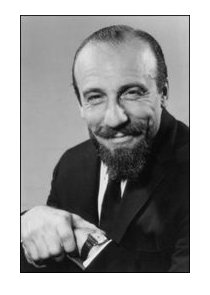 By 1952, Sinatra was gone from Columbia. He went on to sign with Capitol
Records and within a couple of years was back on top, recording a body of
singles and albums that not only sold well at the time but went on to be
regarded as classics. But even without Sinatra, Columbia was still the top
pop label in the world during this period, and at the time Miller seemed
to have the golden touch. He also proved a marketing and strategic genius,
even in the face of adversity. In 1951, when Sinatra was unwilling to record
a pair of songs that he selected, Miller tapped a young singer, Al Cernick,
whom Miller had signed and renamed Guy Mitchell, who cut the two disputed
numbers, "My Heart Cries for You" and "The Roving Kind," which rode the charts
for months and sold more than two million copies and launched a career for
Cernick that lasted for the entire decade and beyond. Doris Day was already
on Columbia when Miller came aboard, but it was during his tenure that she
had her biggest hits, and became a pop culture institution after what had
already been a long stay at or near the top of the charts.
By 1952, Sinatra was gone from Columbia. He went on to sign with Capitol
Records and within a couple of years was back on top, recording a body of
singles and albums that not only sold well at the time but went on to be
regarded as classics. But even without Sinatra, Columbia was still the top
pop label in the world during this period, and at the time Miller seemed
to have the golden touch. He also proved a marketing and strategic genius,
even in the face of adversity. In 1951, when Sinatra was unwilling to record
a pair of songs that he selected, Miller tapped a young singer, Al Cernick,
whom Miller had signed and renamed Guy Mitchell, who cut the two disputed
numbers, "My Heart Cries for You" and "The Roving Kind," which rode the charts
for months and sold more than two million copies and launched a career for
Cernick that lasted for the entire decade and beyond. Doris Day was already
on Columbia when Miller came aboard, but it was during his tenure that she
had her biggest hits, and became a pop culture institution after what had
already been a long stay at or near the top of the charts.He also brought Frankie Laine to the label in the early '50s, and saw success with the signing of Tony Bennett and such discoveries as Mahalia Jackson, Jerry Vale, Rosemary Clooney, the Four Lads, Johnny Mathis, and Johnnie Ray. And Ray, in particular, although unfairly neglected and underrated today, was important not only for the records he sold, but also for bringing a newly youthful caste to early/mid-'50s pop music and popularizing elements of R&B in his singing, all of which helped pave the way for Elvis Presley. Miller also played a small but important role in fostering the middle/late-'50s folk revival when he put the Easy Riders trio under contract. The group had a lively, catchy folk-based harmony sound and also wrote their own material (one of their members, Terry Gilkyson, had composed the Laine hit "Song of the Wild Goose"). As it turned out, they only generated one major hit, "Marianne," in 1957, but they did bridge the gap between the Weavers at the start of the 1950s and the Kingston Trio at the end of the decade, and wrote and recorded songs that became part of the repertoires of both the latter group and the New Christy Minstrels. The latter was also signed to Columbia on Miller's watch, and played a huge role in popularizing folk music at the outset of the 1960s, and in doing so opened a path for artists such as Bob Dylan, Joan Baez, Judy Collins, Phil Ochs, Tom Rush, Leonard Cohen, and others, as well as the Byrds (one of whose key members, Gene Clark, started professionally with the New Christy Minstrels). It was in 1950 that Miller's own recording career as a pop artist and conductor began, with big-scale choral recordings credited to "Mitch Miller & the Gang." Their first hit was a bold rendition of the Israeli folk song "Tzena, Tzena, Tzena," which had also been recorded by the folk group the Weavers around this time. The group later chalked up a six-week run at the number one spot with "The Yellow Rose of Texas," in an arrangement by Don George. Miller and company also enjoyed huge hit singles with numbers like the "Colonel Bogey March" from The Bridge on the River Kwai. In 1958, he began a series of albums as well, in which he led an all-male chorus in rousing, spirited versions of mostly older tunes. These he chose with help from Boy Scout and Girl Scout groups, Rotarian clubs, camp organizations, and similar social groups, asking them what songs they enjoyed singing. "Carolina in the Morning," "Be Kind to Our Web-Footed Friends," "Down by the Old Mill Stream," and "By the Light of the Silvery Moon" were typical fare. Between 1958 and 1962, "Mitch Miller & the Gang" chalked up 19 Top 40 hits, and their success on vinyl led to CBS giving Miller a television series of his own, Sing Along with Mitch, whose artists included a young Leslie Uggams. 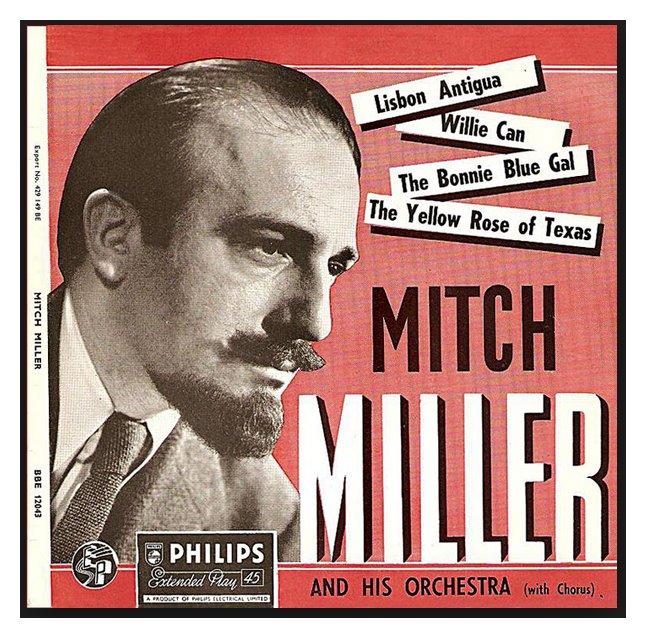 But it was with the recording of cover versions that Miller showed his
greatest marketing acumen. He had first shown this innate ability by getting
Patti Page to record "Tennessee Waltz," back at Mercury. It had previously
been a modest country and R&B hit, but Page's single, as a pop hit,
so overwhelmed all that came before it in sales that few listeners were
even aware that those earlier versions (including one by the composer, Pee
Wee King) had ever existed. This was a key way of dealing with the segmented
nature of the music business, in which different records were aimed at separate
groups of listeners -- a single that was a hit for country audiences, and
played heavily on country music radio stations, might well never get played
on pop stations or heard by pop listeners, and visa versa; jazz and R&B
records, outlets, and audiences were even more isolated from the mainstream.
Additionally, it was customary for record companies -- even the same record
company -- to rush out rival versions of singles that showed promise, and
even a difference of a few days could determine which version of a song became
a hit.
But it was with the recording of cover versions that Miller showed his
greatest marketing acumen. He had first shown this innate ability by getting
Patti Page to record "Tennessee Waltz," back at Mercury. It had previously
been a modest country and R&B hit, but Page's single, as a pop hit,
so overwhelmed all that came before it in sales that few listeners were
even aware that those earlier versions (including one by the composer, Pee
Wee King) had ever existed. This was a key way of dealing with the segmented
nature of the music business, in which different records were aimed at separate
groups of listeners -- a single that was a hit for country audiences, and
played heavily on country music radio stations, might well never get played
on pop stations or heard by pop listeners, and visa versa; jazz and R&B
records, outlets, and audiences were even more isolated from the mainstream.
Additionally, it was customary for record companies -- even the same record
company -- to rush out rival versions of singles that showed promise, and
even a difference of a few days could determine which version of a song became
a hit.Thus, Miller got Frankie Laine to cover "High Noon," the title song to the Gary Cooper western, and Laine's version made it out three weeks earlier than the recording by Tex Ritter -- who had sung it in the movie, but initially had trouble getting his label, Capitol, to get behind the song -- and had a Top Five hit with it. Tony Bennett had a huge pop hit with Hank Williams' "Cold, Cold Heart," and Jo Stafford hit big with "Jambalaya" in the same way. And when Columbia had a country hit with "Singin' the Blues" by Marty Robbins, which had been recorded in Nashville under the guidance of the label's chief of country A&R, Don Law, good marketing sense dictated that Miller should get Guy Mitchell to cut a version for the pop market, which sold over a million copies. Of course, Robbins understandably objected to this effort by Miller, and a subsequent one with Mitchell's version of "Knee Deep in the Blues," believing that it cost him the chance to break into the pop market, and the potential of selling millions more copies of his own singles. But as observers correctly pointed out, this was how the record industry was set up at the time, although the era was drawing to a close. As a recording executive, Miller was very much in tune with the tastes of the times, at least among adults. His work, epitomized by the hit singles and the first Sing Along with Mitch album, was the music listened to by millions of white middle-class (some would say middle-brow) adults who filled the suburbs that had sprung up outside of most cities since the end of the Second World War; and that seemed to suit everyone concerned just fine. Columbia Records at the time was an extension of its parent company, CBS, then known as "the Tiffany Network," with the widest, choicest audience. It had the adult suburban market in popular music, which was the dominant one; it had the Broadway cast album market locked up in ways that the general public was scarcely aware of (the company had an investor's interest in My Fair Lady, the biggest show of the era, and had an ongoing business relationship with Richard Rodgers, whose musicals The King and I, Carousel, and The Sound of Music were perennial sellers on album); it had top jazz artists, including Duke Ellington and, for the college crowd, Dave Brubeck, while those who wanted to push the envelope further could listen to Miles Davis; and in classical it had two of the most prestigious orchestras in the country, the New York Philharmonic under Leonard Bernstein and the Philadelphia Orchestra under Eugene Ormandy, as well as the services of a dozen top virtuosi. Columbia represented dignity, polish, and depth, as embodied by the philosophy of Goddard Lieberson. Unfortunately, none of this left too much room for rock & roll music. Columbia had a foot in R&B through its Epic and OKeh labels, and Don Law in Nashville was free, within limits, to exploit the new music with any signings that he chose to pursue. But rock & roll never played a large role in Columbia's game plan under Miller. He personally loathed most of the music, and with Columbia's share of the pop music marketplace in the late '50s being what it was, he saw no reason to make it more of a priority. He had seriously looked at signing Elvis Presley in 1955, but reportedly balked at the five-figure advances being discussed by his manager, and the cost of buying out Presley's existing contract with Sun Records. And at one point, he also turned down Buddy Holly. 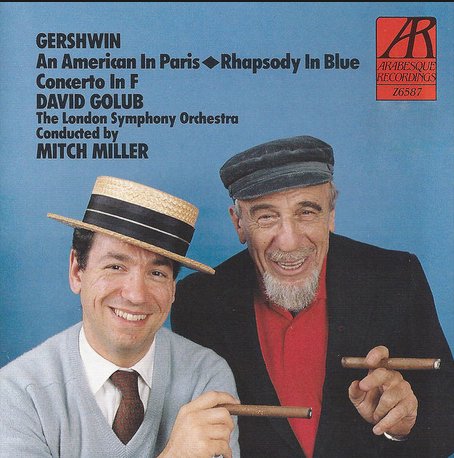 Even as Miller's artists and his own recordings were generating millions
of dollars for Columbia, the label's market share was slowly being undercut
by changes in public taste that he and the rest of the management were doing
their best to ignore. Steve Sholes, the head of A&R at RCA Victor, had
paid the asking price for Elvis Presley (including the buyout of the Sun
contract), and also brought numerous other rock & roll and R&B stars
to the label, and was starting to reap serious rewards for RCA by the end
of 1956. He was reaching out to teenage listeners, and label chiefs at Decca
and Capitol later had Ricky Nelson and the Beach Boys, respectively. Meanwhile,
Miller's most youth-oriented artists of the late '50s and early '60s were
Johnny Mathis and the New Christy Minstrels. At the start of the '60s, sales
on cast albums and adult popular music were still healthy, but their growth
was starting to slacken, while other companies were drawing in millions of
dollars and millions of younger listeners that Columbia simply wasn't addressing
with its releases. It was identified in the minds of teenagers as representing
their parents' music, even as their parents' buying habits were moving away
from buying as much music as they had in the 1950s.
Even as Miller's artists and his own recordings were generating millions
of dollars for Columbia, the label's market share was slowly being undercut
by changes in public taste that he and the rest of the management were doing
their best to ignore. Steve Sholes, the head of A&R at RCA Victor, had
paid the asking price for Elvis Presley (including the buyout of the Sun
contract), and also brought numerous other rock & roll and R&B stars
to the label, and was starting to reap serious rewards for RCA by the end
of 1956. He was reaching out to teenage listeners, and label chiefs at Decca
and Capitol later had Ricky Nelson and the Beach Boys, respectively. Meanwhile,
Miller's most youth-oriented artists of the late '50s and early '60s were
Johnny Mathis and the New Christy Minstrels. At the start of the '60s, sales
on cast albums and adult popular music were still healthy, but their growth
was starting to slacken, while other companies were drawing in millions of
dollars and millions of younger listeners that Columbia simply wasn't addressing
with its releases. It was identified in the minds of teenagers as representing
their parents' music, even as their parents' buying habits were moving away
from buying as much music as they had in the 1950s.Miller's television show remained very popular -- again, mostly with middle-aged and older viewers, which, in those days before audience demographics mattered, was enough to keep it on the air -- and he was something of a media superstar during this period, his smiling, bearded visage as well known as that of any variety show star. He could rightfully take pride in his discoveries of the previous decade -- but by late 1964, it was becoming increasingly clear that the most important artist signed to Columbia so far in the 1960s was not one of his discoveries. Rather, it was a young folksinger and songwriter brought into Columbia by jazz-blues-gospel producer John Hammond, named Bob Dylan. Miller approved of Dylan's signing, amid the burgeoning folk revival, but he was Hammond's discovery, and the producer became something of a hero in the music histories of the period. In fairness, however, the company would never have tolerated Dylan's presence for a moment if Columbia hadn't already been selling substantial numbers of folk (or folk-style) records by the Easy Riders and the New Christy Minstrels, who represented Miller's side of the label's output. And Columbia was already looking at rock & roll a little bit more seriously in 1964 with the signing of Paul Revere & the Raiders, although it took the company a while to figure out exactly what to do with them, especially after their version of "Louie Louie" was eclipsed by a rendition cut by their Pacific Northwest-based rivals the Kingsmen. It was obvious by 1965 that Miller's moment had passed. In particular, the British Invasion spearheaded by the Beatles' success starting early the previous year had put Columbia -- which had no U.K. acts of its own, and had only just acquired its own British label, by buying up Oriole Records -- in an especially weak position, and it was proving to be no brief fad on the part of younger listeners. Additionally, the sales of cast albums -- a mainstay of the company for more than a decade -- began to fall off as the nature and sound of the Broadway musical began changing with the times, and established figures such as Richard Rodgers withdrew from the scene with the passing of time. Miller left Columbia in 1965, the year the company signed the pioneering folk-rock group the Byrds, and their mere presence was a clear break with the past. At around the same time, the company also orchestrated a studio revamping of the sound of a folk harmony duo, Simon & Garfunkel, who had been on the label for a year without much success, in a new, more inventive form. The redubbed, high wattage single of "The Sound of Silence" was as much a new sound as the Byrds' "Mr. Tambourine Man"; their music was arguably the first genuinely new rock & roll sound ever to come from Columbia Records, so new that they seemed to require a different label than "rock & roll." For a company that had scarcely found room for rock & roll on its roster, during the music's first decade, becoming one of the birthplaces of what came to be called "rock" music was a giant step forward. Sing Along with Mitch was finally canceled in 1966, not a moment too soon in the eyes of many viewers, its relentlessly happy tone being very much at odds with how a lot of viewers were starting to feel about the Vietnam War, protests in the street, and all the other strife of the era. Columbia Records was taken over by a new, younger regime under a new president, attorney Clive Davis, who was determined to build its roster in a new direction and, in effect, thrusting the label into the psychedelic era (and beyond) in one fell swoop with signings such as Janis Joplin. Miller occasionally re-emerged as a conductor of light classical recordings, but otherwise disappeared from the music scene after the mid-'60s, at least as a recording artist. He did re-emerge in 1986, hosting a tribute to his late friend Alec Wilder, and his album Sing Along with Mitch was one of the first low-priced CDs issued by Columbia Records in the late '80s. In the 1990s, there existed no less than ten compact discs of Miller's recordings, albeit most of them compilations of his most popular single sides; and though he had left behind recording and the airwaves some 30 years before, he was still a well-recognized figure on the streets of the Upper West Side of Manhattan, where he was still living in his nineties. And, in perhaps the best tribute to his career as an executive and producer, the work of the artists he signed and produced in the 1950s -- including Johnny Mathis, Rosemary Clooney, and Johnnie Ray -- continued to sell 50 years later. Miller himself died shortly after his 99th birthday, in July 2010. ~ Bruce Eder, Rovi [Billboard Magazine website] 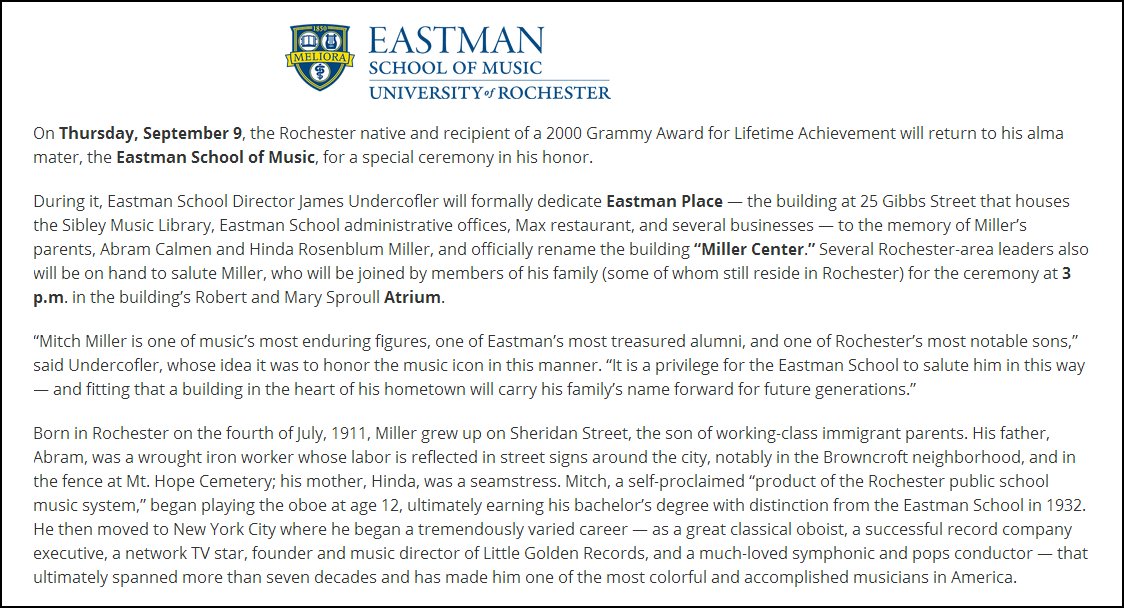
|
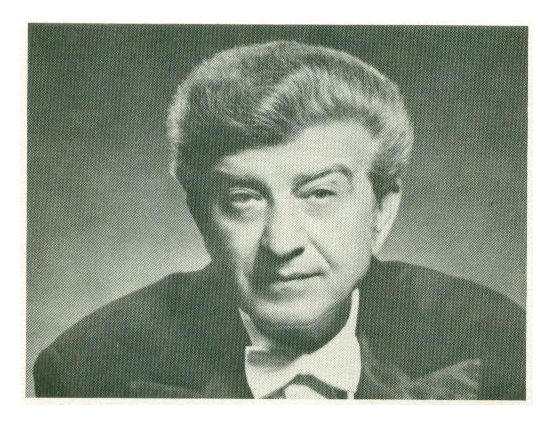
Victor Nicholas Alessandro (November 27, 1915 – November 27, 1976) was an American orchestral conductor. He was born in Waco, Texas, on November 27, 1915. His father, Victor Alessandro (1883–1971) was a prominent conductor and music teacher in public schools. The Alessandros moved to Houston in 1919. Victor was introduced to music at an early age and studied French horn with his father. He made his conducting debut at age four, when he led a children's band in a performance of Victor Herbert's March of the Toys. In 1932, he entered the Eastman School of Music in Rochester, New York, where he studied composition with Howard Hanson. He then went to the Salzburg Mozarteum and the St. Cecilia Academy in Rome, where he studied with Ildebrando Pizzetti. In 1938, at age 22, he became conductor of the Oklahoma City Symphony Orchestra, an organization that he led from a WPA project to an accomplished ensemble with broad civic support. When Max Reiter, conductor of the San Antonio Symphony Orchestra, died in December 1950, Alessandro took over much of the remaining season. He signed a contract as permanent conductor in April 1951. The next year he also assumed leadership of the San Antonio Symphony Society's Grand Opera Festival. Alessandro led works by Tchaikovsky, Wagner and Richard Strauss, Brahms, and the odd-numbered symphonies of Ludwig van Beethoven. He introduced works by Anton Bruckner, Gustav Mahler, and Alban Berg to San Antonio audiences before they became fashionable elsewhere. He conducted performances of Elektra, Salome, Nabucco, Boris Godunov, Susannah by Carlisle Floyd, Die Meistersinger, and the standard operas of Giuseppe Verdi and Giacomo Puccini. In building the San Antonio orchestra it is said that he was an exacting, often irascible taskmaster of high musical standards. Alessandro received three honorary doctorates: Eastman School of Music, University of Rochester, 1948 Doctor of Humanities, Southern Methodist University, May 1956 Southwestern University, Georgetown, Texas, May 1975 In 1956, he received the Alice M. Ditson Award for service to American music. 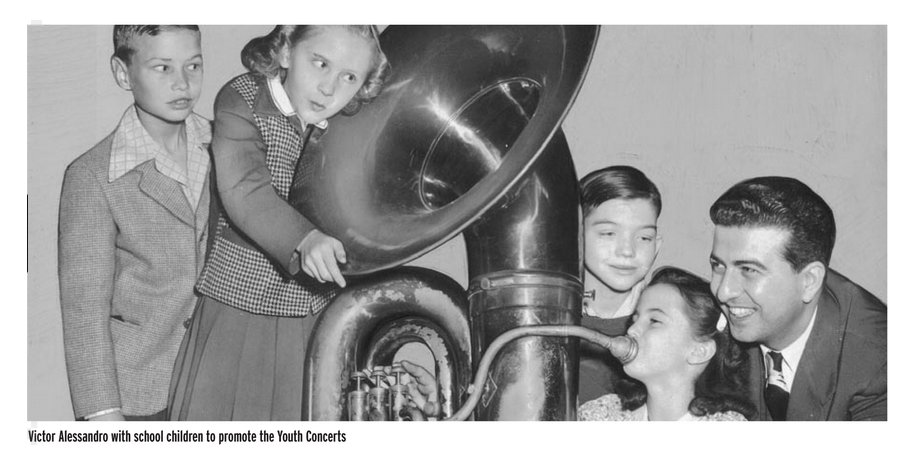
|
|
Goddard Lieberson
Artist Biography by Bruce Eder [Text only - photos from other sources] There is a tendency, in writing and reading about classical recordings, to forget that they're as much a part of business as art -- and that, as a result of this duality, executives can play as important a role as artists in determining what we here and how we hear it. Goddard Lieberson of Columbia Records is one such example. Along with Walter Legge, his opposite number at Britain's EMI Records, Lieberson was perhaps the most influential executive in the field of recording, and specifically classical recording, in the entire world from the 1940s until the '60s. He was responsible, directly or indirectly, for facilitating the industry-wide switch from the three-minutes-to-a-side 78 rpm shellac disc to the 33 1/3 rpm long-playing record, which revolutionized classical listening (as well as jazz and, eventually, pop and rock as well); he was the guiding force behind some of the earliest recordings of complete operas ever done in America; he was the head of Columbia Records during the subsequent switch-over from monaural to stereo recording, a new technology change that Lieberson and Columbia Records transformed into an opportunity, pursuing an aggressive policy of re-recording the standard repertory that, in the process, helped turn newly appointed New York Philharmonic Music Director Leonard Bernstein into a media superstar, and further broadened the audience for classical music in the process; and, as an adjunct to all of this, Lieberson was also the father of the modern Broadway cast recording. 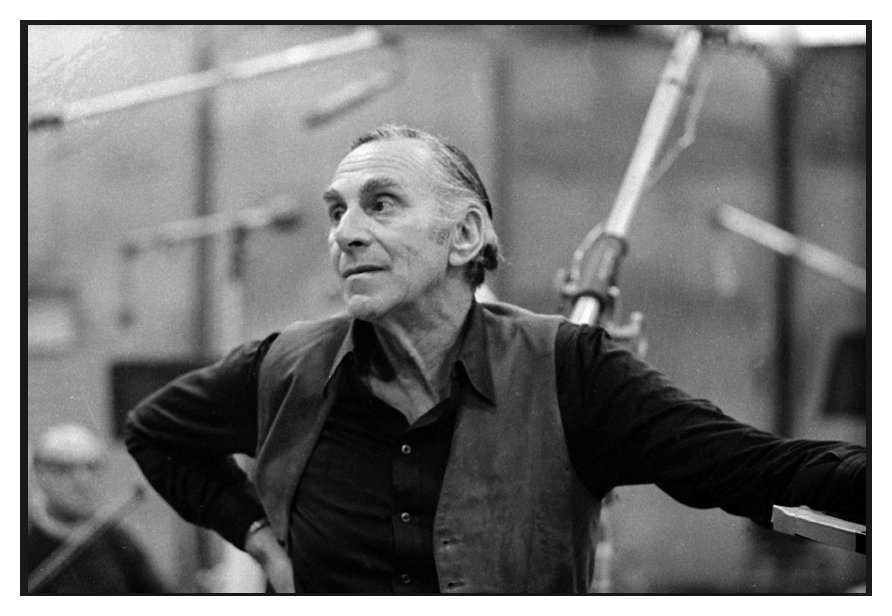
Goddard Lieberson was born in England in 1911. His father was a manufacturer of rubber heels for shoes, and moved the family to America in 1915. He attended the University of Washington and the Eastman School of Music in Rochester, New York. During this period, he also earned money on the side as a nightclub pianist and music critic for the local newspaper. He was a student of composition, and after graduating, made his living teaching music in a private school while he wrote -- by 1939 Lieberson had written more than 100 compositions, several of which had been performed by orchestras under the aegis of the Works Progress Administration, part of the federal government's relief program for creative artists during the Great Depression. Teaching and composing with the support of a government program made for a precarious way of life, however, and in 1939 he went to work for Columbia Records as assistant to the director of the Masterworks division, which was Columbia's classical label. His timing was fortuitous -- the Columbia Broadcasting System (CBS) radio network had just acquired the American Record Company, turning it into Columbia Records. What's more, despite the war about to break out in Europe, the whole company seemed poised for rapid expansion: In contrast to most of the rest of the entertainment industry, radio had boomed in the 30s, the CBS network was flush with cash, and the impending international crisis only boded well for CBS as a major conduit for news and, as a by-product of reporting news, ever larger audiences and revenues. The early to mid-'40s ultimately proved not to be as rewarding as those involved might've hoped. The Japanese conquests in Asia and the Pacific cut off supplies of shellac, an essential ingredient in the manufacture of the 78 rpm discs then in use, but also an essential war material -- from early 1942 until the second half of 1945, the government allowed the recording industry only just enough shellac for the labels to keep their doors open; some categories of music that were considered marginal, either as profit producers or artistic merit, such as "race" (i.e. blues) records and "hillbilly" (i.e. country), were devastated as the major labels trimmed their release schedules. Classical didn't suffer quite as much, even though it wasn't necessarily very profitable -- this was because Columbia and other major labels saw the need and responsibility to cater to the classical audience and the music, regardless of its profitability. Additionally, Columbia had a special commitment to classical music through its already decades-long exclusive contractual relationship with the New York Philharmonic Orchestra (then known as the Philharmonic-Symphony Orchestra of New York). Moreover, there were positive sides to the recording of classical music in the U.S. in those days. Thanks to Hitler's having turned Europe into a literal and cultural charnel house [a charnel house is a vault or building where human skeletal remains are stored. They are often built near churches for depositing bones that are unearthed while digging graves. The term can also be used more generally as a description of a place filled with death and destruction.], hundreds of renowned musicians from the other side of the Atlantic were suddenly living on American shores, eager to work and with any of their pre-existing contractual relationships in Germany, Austria, or the occupied countries voided at least for the duration, if not longer. Bruno Walter, one of the two or three most revered and respected conductors in the world, took the podium of the New York Philharmonic, cutting sides for Columbia in 1941 (including a brilliantly passionate, achingly lyrical recording of Dvorak's Slavonic Dance No. 1 that sounds like a shadow anthem for the Nazi-occupied Czechoslovakia). Joseph Szigeti, newly arrived and seeking asylum and citizenship, was signed by Lieberson, as was Rudolph Serkin. Lieberson also got the company to record then new works by Bartok, Berg, Schoenberg, and Prokofiev, none of whom were well represented in any company's catalogs at the time. It was after the war, however, when the record companies could worry about more than just finding enough shellac to stay in business, and the population started thinking about pleasure and not just survival, that Lieberson's daring and innovative thinking took hold at Columbia. In the process, he ended up transforming not only Columbia but the entire recording industry. Ever since someone attempted to cut the first classical piece of more than three minutes' duration, probably in the first decade of the 20th century on an Edison cylinder, the record industry had chafed under the restricted running time of its existing software. The cylinder's successor, the 78 rpm platter could, under the best of circumstances, hold around four minutes of music on a side. This was a vexation on the artist and the recording manager -- individual movements of works like the Beethoven Symphony No. 5 took up at least two sides, and sometimes three, on two platters, requiring the listener to change platters and interrupt the piece at least once or twice on each movement. Additionally, the artist had to tailor a recording, regardless of the tempo they might've normally used in concert, to meet the side-break at a spot that was as unobtrusive as possible -- that meant hitting the end of a bar, and the right bar, at a pause, at just the right moment in a recording. And the platters themselves were heavy and very brittle, and, thus, easily broken. To top it off, all recording in those days outside of Germany, where they'd perfected a primitive but viable form of magnetic recording tape, was done to disc, on wax masters. There was no such thing as "playback" as such -- if a producer or artist wasn't sure if a note had been hit wrong, or a passage flubbed somewhere deep in the orchestra, they either had to order a test-pressing and wait anywhere from two weeks to a month to get it back, or do it over then and there. If there was doubt, it was faster and cheaper to redo the entire side; thus, retakes were the order of the day -- when Dimitri Mitropoulos and the Minneapolis Symphony cut the first-ever recording of the Mahler Symphony No. 1, for Columbia Masterworks in 1940, it took most of a morning just to get through the first half of the first movement. RCA-Victor had devised an experimental long-play disc in the early '30s, able to fit seven or eight minutes on a side, but it required new playback equipment, and springing that on the public during the depths of the Great Depression, with unemployment inching up to 20- percent and record company profits dropping by 90-percent, didn't seem like a good idea. By the mid-'40s, however, a musician and producer at Columbia named Peter Goldmark proposed another attempt at a new kind of long-playing record -- Lieberson saw the potential that this held and got the development budget allocated, and by 1947 engineers at Columbia had perfected the long-playing, microgroove record, capable of holding 15 minutes on a side in its 10" version, and 22 minutes on a side in its 12" form. The advent of the long-playing record, introduced by Columbia in 1948, revolutionized the whole recording industry, though not immediately. Almost simultaneously with Columbia's new innovation, RCA-Victor debuted its own new music software, the 45 rpm single. It, too, was an improvement over the 78, holding the same three to four minutes of music but being far lighter, cheaper, and easier to make, and far less breakable. Moreover, RCA-Victor, as owner of the National Broadcasting Company, had its own radio and television outlet through which to push the 45 disc. The formats battled it out for three years, although by 1950 there were no more classical 78s to speak of. Some recordings were released in all three formats, and a few as LPs and 45s (one of the oddest releases in opera that one can find is London Records' 45 rpm version of the Beecham recording of The Tales of Hoffmann, from the soundtrack of the 1951 film -- 20 45 rpm discs that allow the listener to go through the opera in 40 three-minute bits, an experience some describe as the juke-box version of Tales of Hoffmann). Eventually, the LP won out for classical and jazz, and as a vehicle for grouped pop releases, while the 45 became the standard for popular music. Coincidental with the development of the LP, Lieberson also established a contractual relationship between Columbia Records and the Metropolitan Opera. The LP made the recording and release of complete operas (which had been done on a very limited basis in Europe in the '30s, before the war) feasible for the first time. Beginning with the Met recording of Puccini's La Bohème in 1947, Columbia began an enviable and unique body of operatic releases that vastly broadened the range of the entire existing classical catalog. Additionally, at approximately the same time, the label began recording various non-operatic classical works whose length would have made a pure 78 rpm release impractical. The most important of these was Bruno Walter's 1947 New York Philharmonic performance of the Mahler Symphony No. 5, the first complete recording of the piece. All of this new recording entailed a massive switch over of equipment in the home. There were tens of millions of old-style 78 rpm players out there, and a hundred times as many wide-tipped steel needles (the V-Disc program alone during World War II had distributed billions of steel needles to troops to play 78s), all of which were useless in playing the LP. The new format spoke its virtues in loud volumes, but more encouragement was needed. Columbia provided this -- for a time in the late '40s, through retailers, the record company supplied new 33 1/3 long-play phonographs at virtually below cost to listeners, in exchange for a commitment to buy a certain number of Columbia LPs. The initial program didn't make money, but the label correctly predicted that once the new players were in peoples' homes, they would buy still more LPs to "feed" them. Every new player moved into a listener's hands at or below cost ensured dozens, and sometimes even hundreds of subsequent record sales. Additionally, each new player in the home was a musical experience waiting to be discovered by a house-guest, relative, or employee, who might then buy his own player and start purchasing LPs. It was so simple a process, especially in those prosperous, pre-inflation days, that it was brilliant. The company thus hastened the end of the 78 rpm record, at least where classical and mainstream pop music was concerned (though the 78 hung on, especially in poor households, Black and White, in the Southern and border states, right to the start of the '60s, as evidenced by the existence of 78 releases by Elvis Presley and Muddy Waters). In some ways, Columbia created a monster that it couldn't entirely control -- much as the success of the compact disc overwhelmed software makers for a time in the '80s, the growth of the LP market was more than Lieberson or Columbia could have predicted. The label scrambled for several years to convert existing 78 releases to LP, because it couldn't make new recordings quickly enough. The arrival of magnetic recording tape in the studios of the major labels at the end of the '40s put the final touch on the revolution that Lieberson started. Now it was possible to instantly replay passages just put down in the studio, edit performances, and cut uninterrupted masters of pieces and movements running 30 to 40 minutes. Columbia was actually a little late in adopting tape, but Lieberson showed that he knew well what to do with it. Now the recording of complete operas was even easier to accomplish, and, moreover, through its ability to be edited, tape gave the producer even more control in the studio. The most important classical creation to arise from these elements was Columbia's 1951 recording of George Gershwin's Porgy & Bess. Recording a full opera, with an all-black cast, by a composer, even one of Gershwin's stature, although he'd been dead about 14 years, was ambitious enough. Lieberson did more than that, however -- as producer of Porgy & Bess, he re-created the ambience of a stage performance in the studio, complete with the sounds of an actual opera house performance. As an adjunctive activity to his work in classical, in 1949, starting with Paul Robeson in Othello, Lieberson also began recording classical and modern plays. At the same time, Lieberson immediately recognized the value that the LP would have in presenting cast recordings of American musicals. Columbia had pioneered this category of recording in 1930 with its studio recording of Jerome Kern and Oscar Hammerstein's Showboat, featuring principal members of the show's original and early casts, but it was in the late '40s that the cast album began its boom period. Lieberson had already recorded Song of Norway and Carousel as 78 rpm releases in 1945 -- they were joined in 1949 by Kiss Me Kate and South Pacific, Guys and Dolls (1951), and the triple-LP extravaganza The Most Happy Fella (1955). These were not necessarily all big sellers, but they sold well over time, very steadily, and they attracted the kind of upscale, educated, middle class and upper-middle class audience that CBS coveted. Still later, Lieberson initiated studio recordings of the scores from shows that hadn't had their runs during the postwar era, including Rodgers & Hart's pre-World War II The Boys from Syracuse. His other pet projects included musical-historical releases such as The Union and The Confederacy, a pair of albums devoted to the patriotic songs from each side of the War Between the States, packaged in big, handsomely illustrated, and heavily annotated gatefold jackets. [The Union is shown in the box above about composer/arranger Richard Bales.] In 1949, Lieberson was elevated to executive vice president of Columbia Records, which gave him the authority to bring in an old classmate of his from the Eastman School of Music, oboist Mitch Miller -- who was amassing a considerable record of success at the newly founded Mercury label -- as head of the company's pop division. Miller, in turn, brought with him Frankie Laine, among other artists, although he did manage to alienate Frank Sinatra in short order, given his penchant for assigning novelty tunes to the artists on his roster. In 1956, Lieberson was promoted to the presidency of Columbia Records. It was during this period that he initiated a series of audio documentary albums in conjunction with the CBS radio and television networks, featuring Edward R. Murrow, called I Can Hear It Now and, later, John Fitzgerald Kennedy . . . As We Remember Him. Columbia was a little slower to embrace stereo recording than several rival companies, including RCA-Victor and Decca-London, but this was due, in part, to the lack of a practical playback machine for stereo LPs in the home until the end of the 50s. When Leonard Bernstein was made the Music Director of the New York Philharmonic in 1957, however, Columbia under Lieberson seized a dual moment -- the label had switched to stereo that year, and here was a chance to sell it, and a generation of new recordings, to the public. The Philharmonic's sales under outgoing music director Dimitri Mitropoulos and his predecessors had always lagged behind those of the Philadelphia Orchestra under Eugene Ormandy, who were also signed to Columbia. Lieberson and Columbia saw the young, charismatic, media-conscious Bernstein as offering the chance to correct that imbalance and sell the new stereo format -- with Bernstein as their point-man, getting lots of publicity (including a fair amount from the CBS network) at the time, as the first American-born Music Director of a major American orchestra (and it should be remembered that these things seemed to, and indeed did, matter a lot more to the public and the press in those days), the company embarked on an ambitious program of recording. Bernstein and the orchestra were offered every chance to go into the studio, recutting (or cutting for the first time) any piece of repertory that might reasonably seem like it would find a serious audience. The result was the creation of a classical music media superstar, and the generation of sales figures for the Philharmonic that not only delighted Columbia but also the orchestra's management. This led to an era in which the Philharmonic musicians' salaries were raised, and the orchestra's schedule expanded to virtually the year round, all to fill the demand. Bernstein and the Philharmonic became the first classical musicians that millions of American children heard, and the only classical musicians that many teenagers of the late '50s and early '60s ever heard. The opening of the Philharmonic's new home, the Lincoln Center for the Performing Arts, in New York in 1963, was the crowning touch, atop these other successes. Nor did Columbia neglect its other commitments -- Bruno Walter was engaged for a glorious and historically essential series of late-career stereo recordings on the West Coast, to which he had "retired" in 1956, that lasted for six years. And Ormandy and the Philadelphia still sold. And to accommodate the presence of yet another world-class American orchestra, the Cleveland under George Szell, as well as a contract to release records by one of the greatest orchestras in Europe, the Amsterdam Concertgebouw, the Columbia offshoot label Epic Records got its own thriving classical division. Epic also became the home for the Italian Baroque ensemble I Musici, who, like the Concertgebouw, were signed to Philips in Europe. Additionally, Lieberson was able to persuade CBS to become the sole backer -- and, thus, holder of all rights -- to the Lerner & Loewe musical My Fair Lady, an unheard-of investment for a record label. The stage production not only ended up earning back many times its investment on its initial run, but the cast album sold millions of copies, and the film rights were ultimately worth millions by themselves -- in addition to which, CBS Video earned millions more with the home video release of the film beginning in the late '80s. It was a golden age, but it couldn't last, partly due to one element of shortsightedness on the part of Lieberson and his pop music director, Mitch Miller. Columbia Records regarded itself as the recording equivalent of its parent company, CBS, which was known in its industry as the Tiffany network. This didn't mean that Columbia didn't cater to the masses -- it had pop music by Rosemary Clooney and Frankie Laine, among numerous others, and a pretty formidable country music division under producer Don Law, and had even gotten one unabashed future superstar in that field, Johnny Cash, away from Sun Records in Memphis. The company also had its hand in R&B through its OKeh and Epic labels, and the records of the Treniers and Roy Hamilton, and had a jazz roster to die for. But Columbia had completely missed the boat that had sailed in 1955/1956 with the advent of rock & roll. Apart from a couple of years trying to get a hit out of Carl Perkins in Nashville, the company seemed almost deaf to the music that millions of teenagers were spending many more millions of dollars on. In a way, it was understandable -- Lieberson usually recorded with a big-picture, of long-term as well as short-term sales in mind, and no one knew how long teenagers would stay interested in rock & roll, or how one developed the career of a maturing rock & roll artist. Producer Steve Sholes at RCA was still trying to write the first version of that strategy with Elvis Presley, and Columbia never found its Elvis Presley. In the early '60s, Columbia did sign a few artists who figured seriously, or at least somewhere in the history rock -- Paul Revere & the Raiders, Bob Dylan (who was a discovery of producer John Hammond), Simon & Garfunkel, the Byrds, and the Cryan Shames. Except for the Raiders and the Byrds, however, none was a success right out of the box. In 1965, to address this gap in Columbia's success, which was made even more glaring in light of the British Invasion of 1964, Lieberson hired entertainment lawyer Clive Davis to run Columbia's pop division. Davis turned Columbia into a powerhouse label in the field of rock music, helping even to define the term "rock" as distinct from rock & roll. Ultimately, Lieberson was "kicked upstairs" in the CBS corporate structure and Davis succeeded him as president of the Columbia label. By that time, more than half of Columbia's sales came from rock music, and classical and cast recordings were receding in importance. In 1973, Davis was suddenly fired in a management shake-up at Columbia, and in his place, Lieberson returned to his old job as president of the label. It wasn't quite like the old days, however -- in the past, the pop divisions of companies like Columbia had made millions with rock & roll, and stood by while the older, presumably wiser heads who favored classical and other music aimed at "mature" listeners parceled out budgets and priorities. Now those executives in the pop division demanded that their units reap the rewards of their success, instead of having resources allocated elsewhere. Lieberson was able to secure the occasional "marginal" project, such as Columbia's cast recording of Stephen Sondheim's A Little Night Music, which he produced himself, but he no longer had the like-minded allies among the top executives that he'd had in the '40s and '50s. Leonard Bernstein, whose excitement and sales had slackened in the late '60s, had given up his Columbia contract and the Philharmonic. His successor, Pierre Boulez, made some very important recordings that didn't sell nearly as well, and his successor, Zubin Mehta, was to make less important recordings that sold even more poorly. The world had changed around Goddard Lieberson. Lieberson died of cancer in the spring of 1977, leaving behind about as large a legacy of important recordings as any man in music. Although his credits as a producer were rare (he was moved up past that level early), he facilitated many important projects in classical music, made Columbia Records' Masterworks division a giant in the field of classical music, and remade the music industry. His son, Peter (1946-2011), was a noted composer in his own right. |
|
Julius Baker
Artist Biography by Robert Cummings 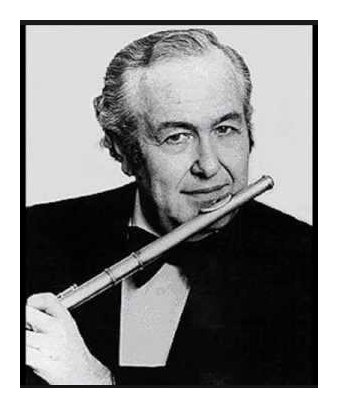 As a flutist of extraordinary skill, Julius Baker distinguished himself
in many musical roles: orchestral prinicipal, chamber player, soloist, teacher,
and recording artist. In the latter realm he was prolific, appearing on
hundreds of recordings, prompting more than a few of his admirers to observe
that anyone who owned classical recordings almost certainly possessed several
of Baker's. He played in the Cleveland Orchestra under Artur Rodzinski, the
Columbia Symphony Orchestra under Bruno Walter, and the New York Philharmonic
under Bernstein, Boulez, and Mehta, making numerous recordings with all
parties. In addition, Baker played in chamber ensembles and with the leading
soloists of the day, like Glenn Gould. He also taught at the Juilliard School
of Music, Curtis Institute, and Carnegie Mellon University, and among his
students were Paula Robison, Eugenia Zukerman, and Jeffrey Khaner. Baker'
recordings of the Mozart concertos, and the complete flute outputs of J.S.
Bach and Handel are still touchstones among connoisseurs of the repertory.
And Baker was hardly less respected in Romantic and twentieth century repertory:
he gave numerous concerts and made acclaimed recordings of works by Beethoven,
Mendelssohn, Saint-Saëns, Fauré, Debussy, Ravel, Poulenc, Nielsen,
Hindemith, and a clutch of composers contemporary to him, including Elie Siegmeister, Lennox Berkeley,
Robert Muczynski,
and countless others. Many of Baker's recordings are still available on Sony,
EMI, Centaur, Titanic, and Vanguard.
As a flutist of extraordinary skill, Julius Baker distinguished himself
in many musical roles: orchestral prinicipal, chamber player, soloist, teacher,
and recording artist. In the latter realm he was prolific, appearing on
hundreds of recordings, prompting more than a few of his admirers to observe
that anyone who owned classical recordings almost certainly possessed several
of Baker's. He played in the Cleveland Orchestra under Artur Rodzinski, the
Columbia Symphony Orchestra under Bruno Walter, and the New York Philharmonic
under Bernstein, Boulez, and Mehta, making numerous recordings with all
parties. In addition, Baker played in chamber ensembles and with the leading
soloists of the day, like Glenn Gould. He also taught at the Juilliard School
of Music, Curtis Institute, and Carnegie Mellon University, and among his
students were Paula Robison, Eugenia Zukerman, and Jeffrey Khaner. Baker'
recordings of the Mozart concertos, and the complete flute outputs of J.S.
Bach and Handel are still touchstones among connoisseurs of the repertory.
And Baker was hardly less respected in Romantic and twentieth century repertory:
he gave numerous concerts and made acclaimed recordings of works by Beethoven,
Mendelssohn, Saint-Saëns, Fauré, Debussy, Ravel, Poulenc, Nielsen,
Hindemith, and a clutch of composers contemporary to him, including Elie Siegmeister, Lennox Berkeley,
Robert Muczynski,
and countless others. Many of Baker's recordings are still available on Sony,
EMI, Centaur, Titanic, and Vanguard.Julius Baker was born in Cleveland, OH, on September 23, 1915. He began flute lessons at nine with his father, a good amateur player. Baker's advanced studies took place at the Curtis Institute, where his most important teacher was William Kincaid. Baker graduated in 1937 and began playing with the Cleveland Orchestra that same year, staying on until 1941. Over the next several decades Baker mixed orchestral work in with freelancing in chamber and solo music, but his orchestral resumé as principal flutist alone was impressive: Pittsburgh Symphony under Fritz Reiner (1941-1943), Chicago Symphony under Rafael Kubelik (1951-1953), and New York Philharmonic (1965-1983). In addition, Baker was active during this time in the Columbia Symphony Orchestra, a recording-only ensemble created by Columbia Records. Baker was also a founding member of the Bach Aria Group, in which he performed from 1946-1964. Baker began teaching at Juilliard in 1954 and at the Curtis Institute in 1981. Baker remained active, especially as a teacher, for most of his remaining years. He died in Danbury, CT, on August 8, 2003. |
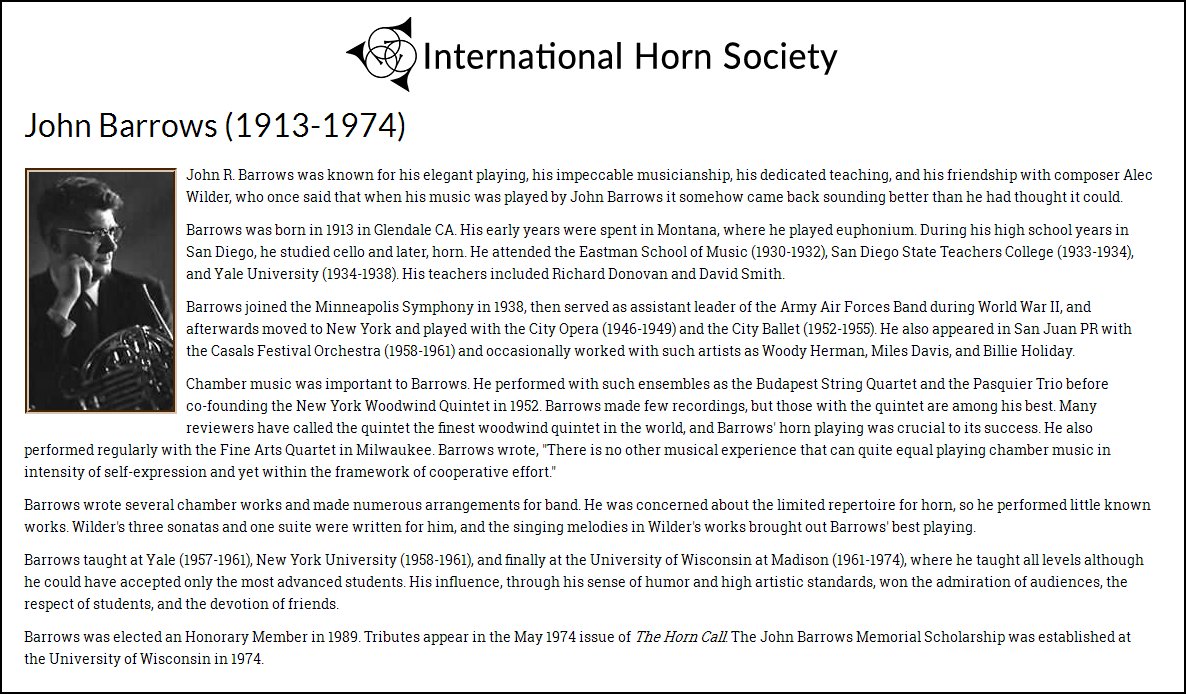
Alec Wilder
Alec Wilder’s music is a unique blend of American musical traditions – among them jazz and the American popular song – and basic “classical” European forms and techniques. As such, it fiercely resists all labeling. Although it often pained Alec that his music was not more widely accepted by either jazz or classical performers, undeterred, he wrote a great deal of music of remarkable originality in many forms: sonatas, suites, concertos, operas, ballets, art songs, woodwind quintets, brass quintets, jazz suites – and hundreds of popular songs. Many times, his music wasn’t jazz enough for the “jazzers,” or “highbrow,” “classical,” or “avante-garde” enough for the classical establishment. In essence, Wilder’s music was so unique in its originality that it didn’t fit into any of the preordained musical slots and stylistic pigeonholes. His music was never out of vogue because, in effect, it was never in vogue. It’s non-stereotypical specialness virtually precluded any widespread acceptance. In his book, “Alec Wilder and His Friends,” Whitney Balliett dubbed Wilder “The President of the Derriere Garde,” and to many classical critics he was a “conservative craftsman lacking in innovation” and not to be taken seriously. Irving Kolodin, a champion of Wilder’s music, commended his native urban style, lamenting that it never became “politically fashionable,” as did the music of many of his contemporaries. Wilder, at his best, represents a fascinating amalgam of three quite different composer-archetypes, here all rolled into one: Gershwin, Poulenc, Villa-Lobos. In its baldest outlines, Wilder’s oeuvre is unusually diverse and characteristically American, a synthesis of the brilliant song writer (Gershwin); the not-too-intellectual, traditional and determinedly conservative composer of easily accessible American-style Gebrauchsmusik, making use of popular and jazz elements as a matter of course (Poulenc); and a sometimes uncritical, too-casual writer who writes too much too easily – like Shakespeare’s old bromide about loving too well but not wisely (Villa-Lobos). Alec Wilder (February 16, 1907-December 24, 1980) was born Alexander Lafayette Chew Wilder in Rochester, New York. He studied composition and counterpoint privately at the Eastman School of Music, but as a composer was largely self-taught. As a young man, he moved to New York City and made the Algonquin Hotel — that remarkable enclave of American literati and artistic intelligentsia — his permanent home, though he traveled widely and often. 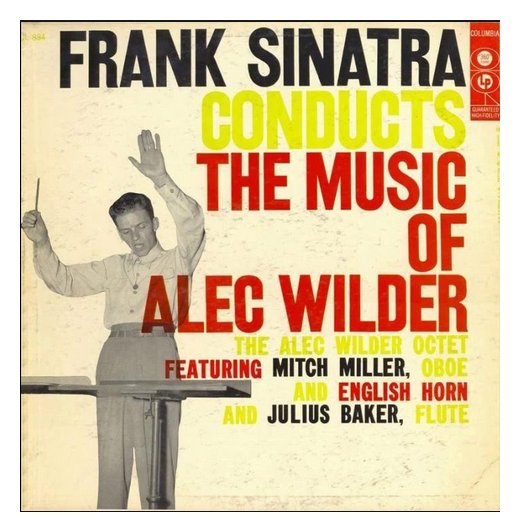 Mitch Miller, whom Wilder met at Eastman, and Frank Sinatra were initially
responsible for introducing his music to the public. It was Miller who organized
the historic recordings of Wilder octets beginning in 1939. Combining elements
of classical chamber music, popular melodies and a jazz rhythm section,
the octets became popular — and eventually legendary — through these recordings,
which preceded by years the much-studied Third Stream movement of the 1950s.
Wilder wrote more than 20 octets, giving them whimsical titles such as Neurotic Goldfish, It’s Silk, Feel It and Jack, This Is My Husband. In 1945, Frank
Sinatra, an early fan and avid supporter of Wilder’s music, persuaded Columbia
Records to record an album of Wilder solo wind works with string orchestra,
Sinatra conducting. The two men became lifelong friends and Sinatra recorded
many of Wilder’s popular songs. His last song, A Long Night, was written in response
to Sinatra’s request for a “saloon” song.
Mitch Miller, whom Wilder met at Eastman, and Frank Sinatra were initially
responsible for introducing his music to the public. It was Miller who organized
the historic recordings of Wilder octets beginning in 1939. Combining elements
of classical chamber music, popular melodies and a jazz rhythm section,
the octets became popular — and eventually legendary — through these recordings,
which preceded by years the much-studied Third Stream movement of the 1950s.
Wilder wrote more than 20 octets, giving them whimsical titles such as Neurotic Goldfish, It’s Silk, Feel It and Jack, This Is My Husband. In 1945, Frank
Sinatra, an early fan and avid supporter of Wilder’s music, persuaded Columbia
Records to record an album of Wilder solo wind works with string orchestra,
Sinatra conducting. The two men became lifelong friends and Sinatra recorded
many of Wilder’s popular songs. His last song, A Long Night, was written in response
to Sinatra’s request for a “saloon” song.It is a relative rarity for a composer to enjoy a close musical kinship with classical musicians, jazz musicians and popular singers. Wilder was such a composer, endearing himself to a relatively small but very loyal coterie of performers and successfully appealing to their diverse styles and conceptions. He wrote art songs for distinguished sopranos Jan DeGaetani and Eileen Farrell, chamber music for the New York Woodwind and New York Brass quintets, large instrumental works for conductors Erich Leinsdorf, Frederick Fennell, Gunther Schuller, Sarah Caldwell, David Zinman, Donald Hunsberger and Frank Battisti, many of whom premiered his works for orchestra or wind ensemble, and for concert soloists who recorded or premiered his music, including John Barrows, horn; Bernard Garfield, bassoon; Harvey Phillips, tuba; David Soyer, cello; Gary Karr, string bass; Barry Snyder, piano; Samuel Baron, James Pellerite and Virginia Nanzetta, flute; Donald Sinta, saxophone; Glenn Bowen, clarinet; Robert Levy, trumpet; Gordon Stout, marimba. It was John Barrows, who served as Wilder’s friend and mentor, not only urging him to compose in the larger forms but also introducing him to many of his musician colleagues. Jazz musicians fascinated Wilder with their gift for creating extemporaneous compositions. Among those for whom he composed major works were Marian McPartland, piano; Stan Getz, Zoot Sims and Gerry Mulligan, saxophone; Doc Severinsen and Clark Terry, trumpet. Entire albums of his songs and shorter pieces were recorded by Bob Brookmeyer, trombone; Roland Hanna and Marian McPartland, piano; Dave Liebman and Bob Rockwell, saxophone; Robert Levy, trumpet and Vic Juris, guitar. Individual Wilder songs have been recorded, notably by such jazz artists as Stan Getz, Chet Baker, George Shearing, Keith Jarrett, Kenny Burrell, Maynard Ferguson, Bill Dobbins, Fred Hersch and Bill Charlap. Wilder’s relationship with popular and jazz singers was especially close. Despite his songs’ sinuous angular melodies and unorthodox forms, he was admired and respected not only by Frank Sinatra, Mabel Mercer, Mildred Bailey, Peggy Lee and Tony Bennett, for whom he wrote songs, but by Marlene VerPlanck and Jackie and Roy, who recorded Wilder albums. Among his best-known songs are It’s So Peaceful in the Country, I’ll Be Around, While We’re Young and Blackberry Winter. Sometimes Wilder wrote the lyrics for his songs, but more often he collaborated with the brilliant lyricist William Engvick, and in later years the outstanding Loonis McGlohon, as well as with Johnny Mercer, Marshall Barer and librettist Arnold Sundgaard. His collaborations resulted in larger-scale works, expanding his song concept into operas and musicals. Miss Chicken Little (1953), written with William Engvick and based on the familiar children’s story, is considered an opera though it was televised as an Omnibus program. Wilder also had an ongoing collaboration with Arnold Sundgaard, known for his work with Kurt Weill on Down in the Valley and his Pulitzer Prize-winning opera Giants in the Earth with Douglas Moore. The operas Sunday Excursion (1953) and The Opening (1969) and the musical comedies Kittiwake Island (1953) and Nobody’s Earnest (1973) are examples of their work together. Closely related to his large-scale opera writing was Wilder’s work on film scores. Friend and filmmaker Jerome Hill asked him to do three film scores: the Academy Award-winning documentary Albert Schweitzer (1957), The Sand Castle (1959) and Open the Door and See All the People (1963). 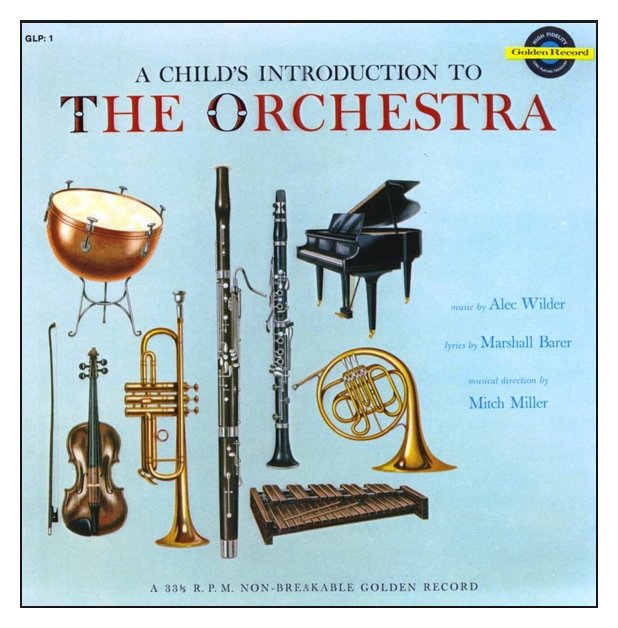
Wilder’s interest in children resulted in hundreds of piano pieces, easy study pieces for many different instruments, A Child’s Introduction to the Orchestra (with Barer) and the songbook Lullabies and Night Songs (with Engvick and illustrated by Maurice Sendak). His cantata, Children’s Plea for Peace, is a testament to his hopes for a better world for young people. He also wrote many children’s songs for television productions and records, such as The Churkendoose (with Ben Ross Berenberg), performed by Ray Bolger, and versions (both with Engvick) of Pinocchio, starring Mickey Rooney, and Hansel and Gretel, featuring Barbara Cook. The children of many musician friends were remembered with numerous solo chamber works. In the early 1950s, Wilder became increasingly drawn to writing concert music for soloists, chamber ensembles and orchestra. Throughout the rest of his life, he produced dozens of compositions for the concert hall, writing in his typically melodious and ingratiating style. His output includes solo suites with piano or sonatas for every orchestral instrument (often more than one, as with horn, bassoon and tuba), ten brass quintets, nearly 20 woodwind quintets and numerous combinations of winds and brass- especially for clarinet, bassoon, horn and tuba. His works are fresh, strong and lyrical, and very much “in the American grain.” Many pieces include movements that express a kind of melancholy desolation, an unself-pitying loneliness in contrast to the more buoyant and witty surrounding fast movements. Alec Wilder said he wrote music because it was the only thing that could content his spirit. He declared, “I didn’t do well in terms of financial reward or recognition. But that was never the point.” Wilder shunned publicity and was uncomfortable with celebrity. If he never was one to get grants, receive commissions or win prizes, it was because he never sought them. A deep distrust of institutions, combined with an extraordinary shyness verging on an inferiority complex, prevented him from circulating and operating in the composer’s world in the ways generally expected. Nonetheless, his awards eventually included an honorary doctorate from the Eastman School of Music, a Peabody Award for the National Public Radio series “American Popular Song,” cohosted by Loonis McGlohon, an Avon Foundation grant, the Deems Taylor ASCAP Award and a National Book Award nomination — all having to do with American Popular Song: “The Great Innovators, 1900-1950,” edited and with an introduction by James T. Maher. He included almost everyone who had written a song of quality, but not one word about himself or any of the hundreds — maybe thousands — of songs he wrote. Wilder was awarded a Guggenheim Fellowship (unused) just before his death and in 1983 was posthumously inducted into the Songwriters’ Hall of Fame. The Alec Wilder Archive and Reading Room in the Sibley Music Library, Eastman School of Music, was dedicated in 1991. 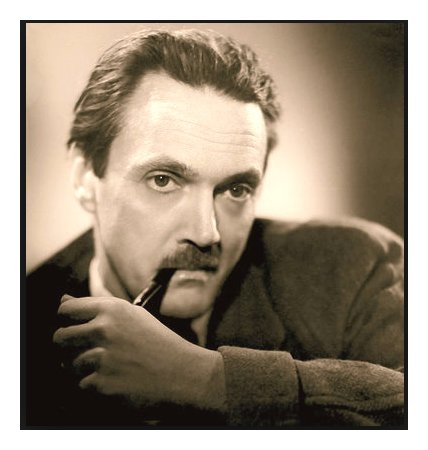 No one will ever be sure just how much music Wilder wrote. Sketches of
music — sometimes entire pieces — were often written on small scraps of
manuscript paper while he rode a train, sat on a park bench or waited in
an airport terminal. Scattered about in private collections of Wilder’s friends
were many compositions that never reached performance or publication. Some
may still lie in piano benches and desk drawers wherever Wilder visited,
for he wrote almost entirely for friends, and most of his pieces were gifts
to them or their children.
No one will ever be sure just how much music Wilder wrote. Sketches of
music — sometimes entire pieces — were often written on small scraps of
manuscript paper while he rode a train, sat on a park bench or waited in
an airport terminal. Scattered about in private collections of Wilder’s friends
were many compositions that never reached performance or publication. Some
may still lie in piano benches and desk drawers wherever Wilder visited,
for he wrote almost entirely for friends, and most of his pieces were gifts
to them or their children.What those who knew him well respected in Alec Wilder was his absolute independence and incorruptible aesthetic integrity as an artist. For years he wrote music of taste and quality with that personal melodic touch that was all his own, unaffected by musical fashion or fad and never accepting any form of financial remuneration. And no one was more devoted to the musician in providing a playable, functional literature for all those instruments and instrumental ensembles that most composers generally ignore. It was almost a mission in Wilder’s life to assuage the thirst for good music for the so-called underdog instruments: bass, tuba, euphonium, horn, marimba, et al. He was truly the musician’s friend — an American original. Despite his slightly rumpled-professor look, Alec Wilder always had a touch of unpretentious elegance and style, always with coat and tie, reflecting a comparable blend of spontaneous looseness and formal discipline in his music. There was also humor — sly humor, the humor of an intelligent, sensitive mind — in his music. Wilder was generous to a fault, famous for giving books to his friends. He was also unpredictable, as in his music. Just when one seems to have guessed where he will take us in the next phrase, he surprises us by taking a completely unlikely turn — which in retrospect almost always seems inevitable and right. Not all of Wilder’s compositions are light and happy and easily accessible; some of his music — especially that written in his last years — is dark and anguished, reflecting a deep loneliness. And there were sometimes prolonged periods of discouragement and cultural isolation during which he found it impossible to write music at all. Although he protested the label (perhaps sometimes too vigorously), Alec Wilder was a bonafide eccentric. If some of his music sometimes has a lopsided, irregular shape, it is because he intended to throw us off guard in making a musical or emotional point. In his popular songs, he often created seven- and nine-bar phrases, which, nonetheless, always feel as natural as the more orthodox eight-bar structures of Tin Pan Alley. That he could also work well within these more traditional forms is born out by hundreds of songs and instrumental pieces. Alongside his more complex sinuously winding melodies, Wilder could also create tunes of haunting simplicity. I’ll Be Around is surely an extraordinary example of the latter, while the ravishing theme of Serenade from the Jazz Suite for Four Horns is a superior representative of the former, a melody worthy of an Ellington, a Gershwin or a Schubert, and arguably one of the most beautiful melodies composed in the 20th century. Most of Wilder’s chamber music was unpublished until the last years of his life. Now, a quarter of a century since his death, it is heartening to see new recordings released by a younger generation discovering his music for the first time. Alec Wilder died of lung cancer on Christmas Eve 1980 in Gainesville, Florida — “just in time to keep from becoming better known,” as he might have quipped. Compiled by Gunther Schuller, Robert Levy, Loonis McGlohon, and Judy Bell [Text only - photos added for this website presentation] |
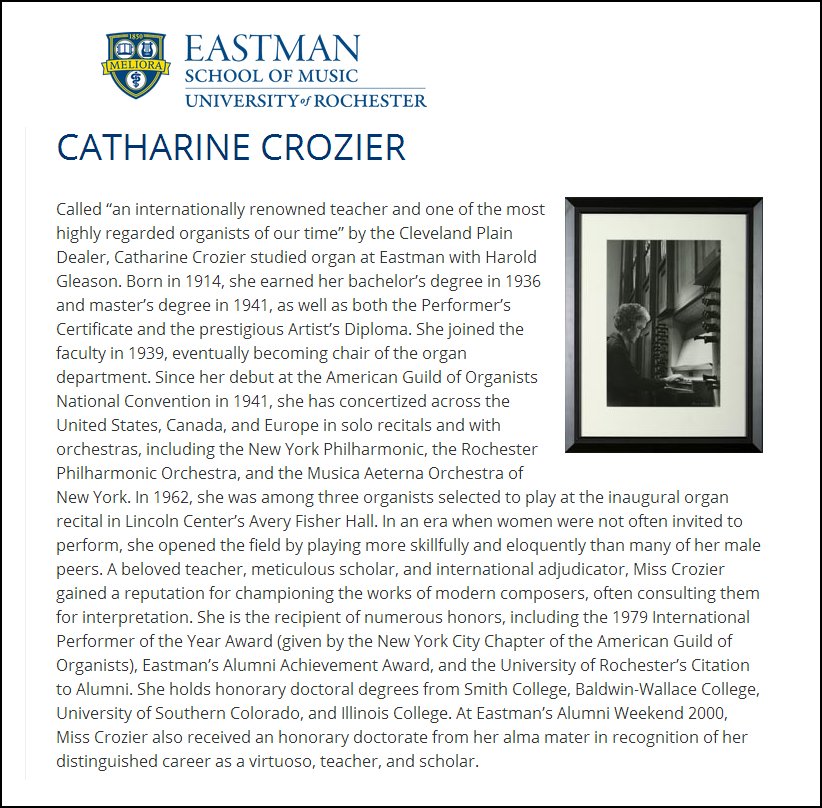
|
Gail Kubik
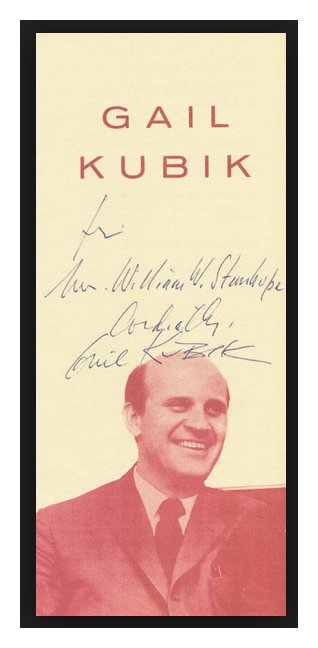 Artist Biography by Uncle Dave Lewis
Artist Biography by Uncle Dave LewisGail Thompson Kubik was born in Oklahoma to a father of Bohemian descent and a mother who was a concert singer and student of Ernestine Schumann-Heink. Kubik and all his siblings were subjected to a musical grounding from earliest childhood. In 1930, the Kubiks formed a chamber ensemble that toured the American Midwest until 1937. In 1929, Kubik was awarded a scholarship to the Eastman School of Music. Many college students of the 1930s endured the Depression by staying within the educational system, and Kubik likewise passed the entire decade either as a student or teacher. He took violin from Samuel Belov and Scott Willits, and premiered his First Violin Concerto in Chicago in 1938. Kubik studied composition with Leo Sowerby and Walter Piston, among others. Also in 1938, Kubik attracted attention through a work based on folklore, In Praise of Johnny Appleseed, for bass-baritone, chorus and orchestra. In 1940, Kubik left the teacher's college at Columbia University in order to take a position writing music for radio drama programs at the NBC. In 1942, Kubik scored his first film, The World At War. This won an NAACC award, and Kubik was named musical director for the military film unit at OWI headed by Frank Capra. Kubik wrote scores for the Why We Fight series; one of them, The Memphis Belle, he turned into a concert work with narrator. During this time, Kubik's Second Violin Concerto won a competition sponsored by Jascha Heifetz. As Kubik was discharged from the military in 1946, he was awarded a Guggenheim Fellowship, and composed a folk opera, A Mirror for the Sky, and a ballet for dance band and singer, Frankie and Johnny. The late 1940s were busy for Kubik; scoring films, writing his First Symphony and fulfilling commissions. In 1950, Kubik collaborated with Ted Geisel (also known as "Dr. Seuss") on a project entitled Gerald McBoing Boing, the first fruit of which was a 78-rpm children's record narrated by Harold Peary (The Great Gildersleeve). Geisel sold Gerald McBoing Boing to Steven Bosustow of UPA, who produced it as an animated cartoon directed by Bob Cannon. Gerald McBoing Boing won an Oscar in 1951 for best animated short; Kubik earned another for its music. In 1950-51 Kubik was the recipient of the Prix de Rome and served three years at the St. Cecilia Academy. In 1952, he composed his Sinfonia Concertante, which earned Kubik the 1952 Pulitzer Prize in Music. In 1953, Kubik published a concert version of Gerald McBoing Boing, which has been a children's concert staple ever since. In 1955, Kubik returned to the U.S. to write his final film score, The Desperate Hours, and responded with his Third Symphony to a commission from Dmitri Mitropoulos and the New York Philharmonic. In 1959, Kubik returned to Europe, ostensibly to teach and compose, until 1967, but little was accomplished in this second European sojourn. Returning to Kansas State University in 1967, Kubik was happy to accept a President's commission for A Record of Our Time, set for narrator, vocal soloist, chorus, and orchestra. With a text compiled by Kubik and novelist Harvey Swados, this was premiered in Manhattan, Kansas on November 11, 1970, with Ray Milland as narrator. That same year, Kubik accepted his final teaching post, composer-in-residence at Scripps College in Claremont, California, that he held until his retirement in 1980. Kubik's last major work was Magic, Magic, Magic, composed in 1976 for the Texas Bicentennial, and premiered in San Antonio. Gail Kubik died at age 69 in 1984. |
| Arthur Whittemore, 69, Dies;Member of Two-Piano Team UPI 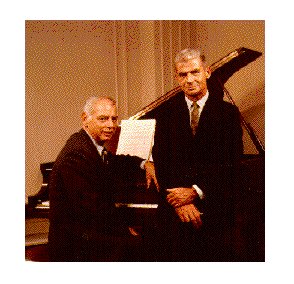 SOUTHAMPTON, L.I., Oct. 25, 1984 — Arthur Austin Whittemore, the pianist
who, as a member of the two-piano team of Whittemore and Lowe, performed
with most of the major symphony orchestras in the United States, died on
his 69th birthday Tuesday.
SOUTHAMPTON, L.I., Oct. 25, 1984 — Arthur Austin Whittemore, the pianist
who, as a member of the two-piano team of Whittemore and Lowe, performed
with most of the major symphony orchestras in the United States, died on
his 69th birthday Tuesday.Mr. Whittemore was born Oct. 23, 1915, in Vermillion, S.D. He lived in Quogue, L.I., and died at Southampton Hospital after a long illness. Mr. Whittemore and Jack Lowe began their collaboration when they were students at the Eastman School of Music in Rochester. They made their debut at Town Hall in New York in 1940. Both served in the Navy in World War II. After the war, they returned to the concert stage, where they averaged more than 70 concerts a year in the United States, Canada and Europe. Mr. Whittemore is survived by four sisters, Helen Vann of Dunevin, Fla.; Dorothy Olson of Tierra Verde, Fla.; Rosalind Tollefson of Sioux Falls, S.D., and Elizabeth Osborn of Stockton, Kan., and 12 nieces and nephews. Memorial services were scheduled for 2 P.M. Saturday at the Presbyterian Church in Quogue. The family requested that donations be sent to The Whittemore House, a historical museum in Vermillion, S.D. 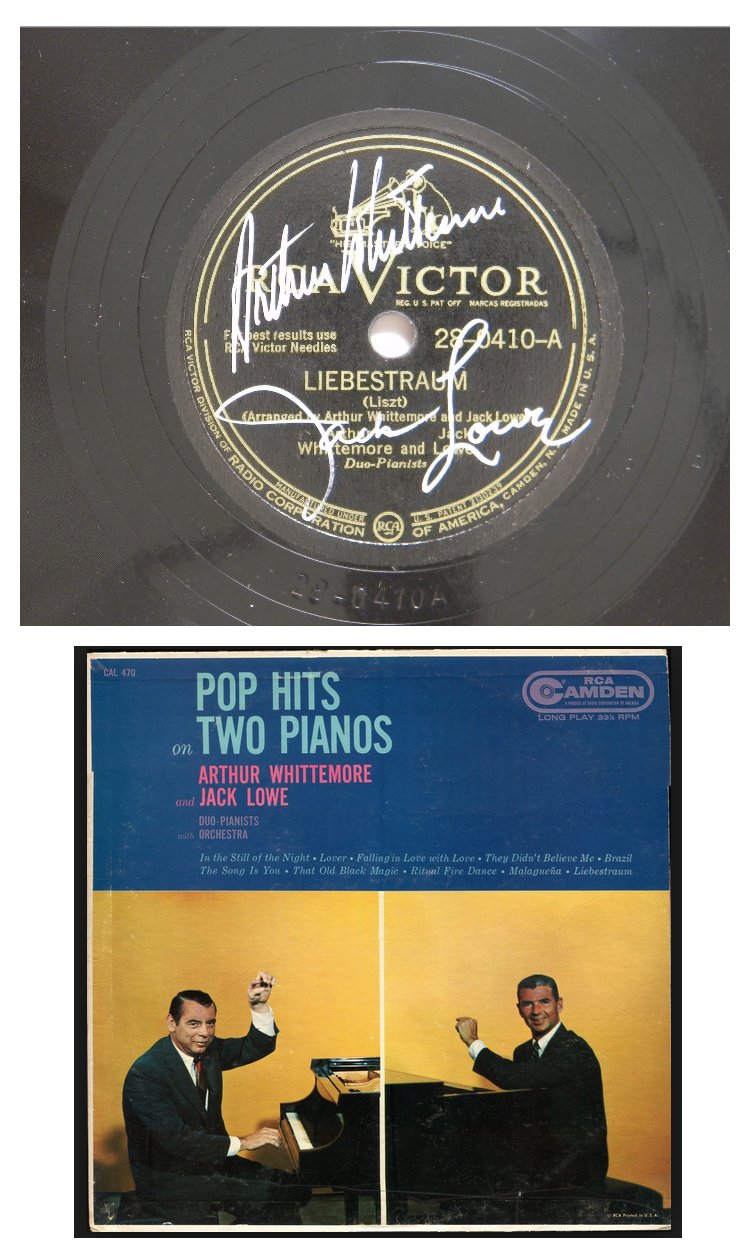
Jack Warren Lowe, 79, Pianist Best Known as Half of a Duo By ANTHONY TOMMASINI, published in The New York Times, JUNE 10, 1996 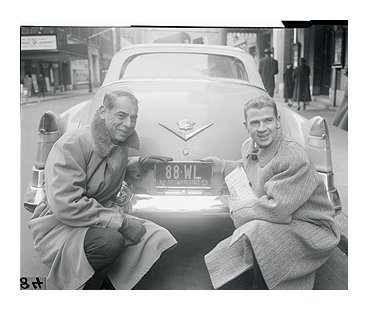 Jack Warren Lowe, for more than 40 years the partner of Arthur Whittemore
in a popular duo-piano team, died on June 2 at his home in Boynton Beach,
Fla. He was 79 and had suffered from emphysema.
Jack Warren Lowe, for more than 40 years the partner of Arthur Whittemore
in a popular duo-piano team, died on June 2 at his home in Boynton Beach,
Fla. He was 79 and had suffered from emphysema.When the duo made their debut in 1940 at Town Hall in Manhattan, the reviews were supportive but unexceptional. The New York Times critic Howard Taubman wrote that the pianists "may not burn up the world as a two-piano team, but they play pleasantly and with a well-considered and well-integrated balance of instruments." But the pianists quickly achieved success, thanks to their pleasing stage manner, breezy flair and innovative programming, which mixed classical and popular works. Over the next 15 years, their recordings sold more than one million copies. "Two Grand," an album recorded with the RCA Victor Orchestra and featuring their arrangements of pop hits like "In the Still of the Night," became a best seller. They continued to play classical repertory, notably the Poulenc Two-Piano Concerto with Dimitri Mitropoulos . Mr. Lowe was born in Aurora, Colo. He attended Colorado State Teachers College and earned a master's degree from the Eastman School of Music in Rochester, where he eventually taught. It was there that he met Mr. Whittemore. In 1942, both men enlisted in the Navy. During their four-year tour of duty, they presented more than 700 concerts at bases and hospitals in the Pacific and on radio broadcasts from the United States. After the war, they achieved success on radio and television, particularly on "Music in Silhouette," on WOR-TV in New York. In later years, they lived as neighbors in Quogue, L.I. Mr. Whittemore died in 1984. In retirement, Mr. Lowe taught music appreciation at the Boynton Beach Public Library. No immediate family members survive. |
Webster Aitken
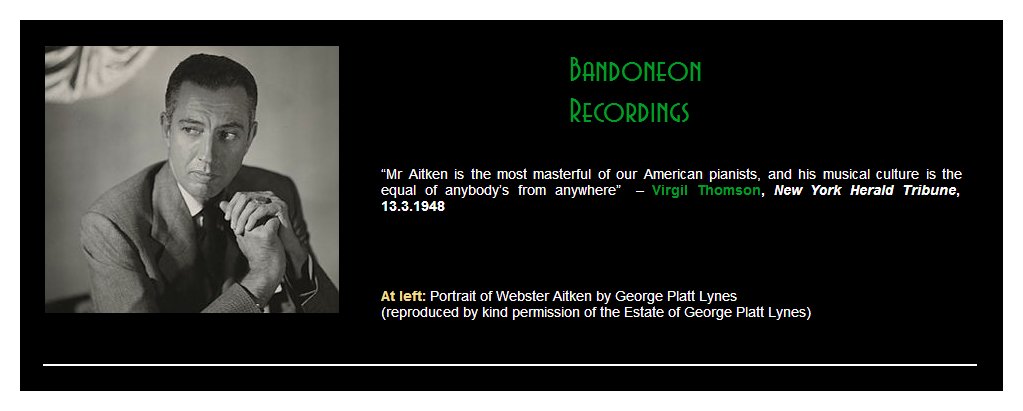
Early Years Born June 17, 1908 in Los Angeles, California, Webster Aitken was drawn to his future instrument from a young age: “I ‘played’ the piano from my earliest years, for hours on end, I am told; a severe trial for all within range of hearing. I took the greatest delight in molding handfuls of sound (especially on days when I was kept home from school on account of croup) out of the available 88 notes of the keyboard, setting up dazzling towering effects that put everybody’s teeth on edge, for of course I couldn’t read music and had no idea of any rules and regulations.” Blessed with perfect pitch, Aitken’s gifts were soon recognized, and both his father, a newspaperman, and his mother, a fine amateur pianist, greatly encouraged their son. He auditioned for the Leschetizky pupil Jode Anderson, who had set up in LA’s Majestic Theater at 9th and Broadway, and after several lessons was turned over to his assistant, Eunice Landrum. He practiced long and hard, much to his father’s delight, at a piano reduction of Scheherezade, having heard it in concert. His mother sometimes played for him, “our favorite piece being Chaminade’s Flatterer. She had studied and played some of the simpler Beethoven Sonatas out of a thin paper Novello edition edited by one Agnes Zimmerman. It was out of this book that I picked my way through Opus 106 for the first time, fascinated at the notational and rhythmic puzzle of the transition to the fugue. The convolutions of the slow movement, an insoluble unapproachable mystery: to be confronted with such complications, having just started out in the pursuit of music, made me think I was about to get lost on an undiscovered planet.” He would also work with pianist Alexis Kall and attend the masterclasses of Alfred Mirovitch. In fact, the latter would introduce his aspiring young student to one Sergei Prokofiev, during the Russian Enfant Terrible’s 1928 American tour. Transatlantic Musical Training and European Debuts Aitken would study for a year with Herbert Simpson at Curtis, before departing for Europe in 1925 at the tender age of 17. In Berlin he worked under Emil von Sauer, and with Leschetizky’s one-time assistant Marie-Prentner. After three years intensive study, he was accepted as a pupil of Artur Schnabel, making his recital debut in Vienna in 1929. Also the scene of his first orchestral engagement, Aitken played the Schubert-Liszt Wanderer Fantasy with the Vienna SO and conductor Paul Kerby. A happy period in the pianist’s life, Aitken wrote: “As a student, Berlin was the scene of much hard work and gayety: the rest of Germany and Austria, in the late twenties and thirties seemed expressly to exist for skylarking about in.” An American Homecoming: Debuts and Engagements Aitken’s American debut came 17 November 1935 at New York’s Town Hall in a program that included Beethoven’s Diabelli Variations, The New York Times writing: “There was individuality in all of the pianist’s work and a seriousness of purpose and loftiness of ideals which were reflected in the chaste and severely classical program he had chosen.” Then in 1937 he played Beethoven’s Concerto No. 2 Op. 19 with Klemperer and the LAPO, a homecoming for a local boy made good. The 1938 Schubert Piano Sonata cycle at Æolian Hall Although he first appeared in England as early as 1933, his most important European foray came in 1938 at London’s Æolian Hall, where – in a 4 recitals given November 10, 17, 22, and 29 – he presented that city’s first Schubert Piano Sonata cycle, embracing D. 537, 568, 575, 664, 784, 840 (in a completion by Krenek), 845, 850, 894, 958, 959, and 960. Well-received, this path-finding survey prompted an article by Richard Capell for the Daily Telegraph and Morning Post entitled "Revaluation of a Neglected Heritage," which for many years was held as a landmark in Schubertian literature. 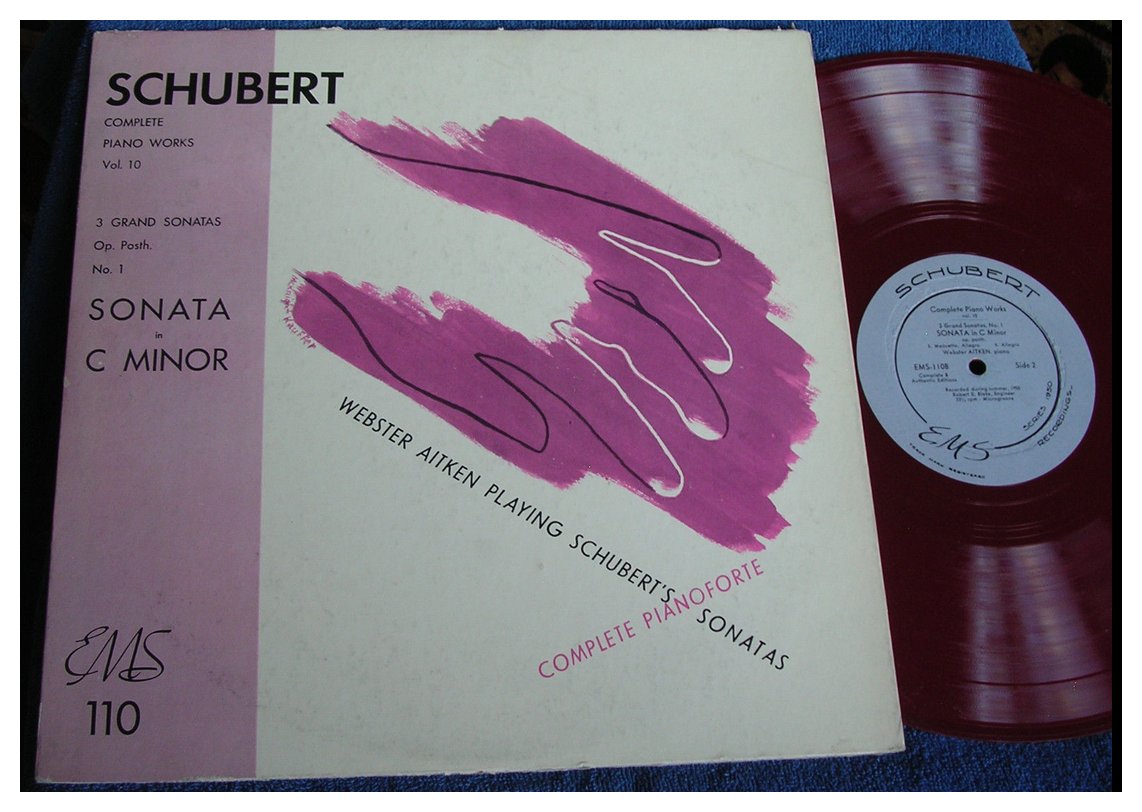
War-time Engagements Other engagements followed: at Carnegie Hall in 1939, in Bach’s Concerti for 2 Pianos, BWV 1061 (with Kurt Applebaum), and 3 Pianos, BWV 1064 (with Rosalyn Tureck and Frank Sheridan) accompanied by Fritz Stiedry and the Friends of New Music Orchestra. That same year, Aitken was soloist in a broadcast of Mozart’s Piano Concerto No. 15 K. 450 with Léon Barzin and the National Orchestral Association. During the war years, Mozart remained his principal calling card, Aitken appearing with Koussevitzky and the BSO (1940, Piano Concerto No. 15 K. 450), with Walter and the NYPO (1941, No. 27 K. 595), and with Goossens and the Cincinnati SO (1942, No. 25 K. 503). New Music and New Directions – Premieres of Ives and Carter In the post-war years, Aitken broadened his musical activities by way of teaching, as well as by bringing the music of contemporary composers to the concert stage. In 1947 he joined the Dept of Music, Carnegie Institute of Technology as Visiting Professor of Piano, spurned perhaps by his appearance in Pittsburgh the year before at the International Society for Contemporary Music (ISCM) Festival. There, Aitken played the Piano Sonatas of Aaron Copland, Igor Stravinsky, and Virgil Thomson (No.1). In a New York broadcast February 16, 1947, Aitken gave the world premiere of Elliot Carter’s Piano Sonata, one of the last works of its kind to enter the central repertoire. Alas, the broadcast does not survive, nor did Aitken ever take it into the studio. At New York’s Town Hall on March 12, 1948, Aitken gave the first known complete performance of Charles Ives’s Four Transcriptions from Emerson. Also on the program: Beethoven’s Piano Sonata No. 32, Scarlatti Sonatas in E and D Major, and Menotti’s Ricercare and Toccata, the last a New York premiere. A Return to Europe: “Journey Into Darkness” In 1949 Aitken traveled to Berlin under the auspices of the U.S. Army’s Visiting Artists Program, finding the battle-scarred city’s destruction stupefying, and recording his impressions in a 47-page essay entitled Berlin Diary, Journey Into Darkness: “The city of Berlin today looks as though the blueprints for its construction might have been prepared by Edgar Allen Poe in a fit of necrophilia. The ruins have a terrifying timelessness that puts them beyond every canon of architectural taste, utility, and soundness…The Reichstag, the Kroll Oper, tangles of twisted girders, resembling empty bird cages. Beyond the Brandenburger Tor, the blocks seem to be made of brown sugar that has gone hard in lumps and streaks: what is left of block after block of buildings, sits there, with the rubble drawn up to its knees…There are no concert halls left in Berlin: the familiar haunts no longer exist: Beethovensaal, Bechsteinsaal, Singakademie.” Aitken visited the famous Bote & Bock to buy what music he could find that was either interesting or available, only to find Berlin’s premiere music seller had not been spared: “As a matter of fact, Bote & Bock, occupying a couple of rooms in a gutted house, showed me their entire stock of piano music in less than ten minutes, none of it of more than routine interest. When we came to the T’s, I was surprised to see a great stack of Tchaikovsky. On expressing this surprise I was reminded that Leipzig is in the Russian zone and that the Russians see to it that Russian composers are the first to be reprinted.” In Berlin he would meet the pianists Helmuth Roloff and Gerty Herzog, hearing the latter in the Piano Concerto of Boris Blacher, a composer he would also come to know, describing him as “a genuine, if perhaps, malicious wit, together with an absence of illusion and a most un-teuton-like lack of sentimentality, lifted his conversation to a level of virtuosity that made you fairly quiver with delight.” He appeared with Celibidache at Titania Palast and with Willem van Hoogstraten in Stuttgart, played Beethoven’s Emperor Concerto in Munich, and recorded a recital for radio broadcast (now lost). He would miss by days separate Schubert recitals given by pianists Wilhelm Kempff and Eduard Erdmann. 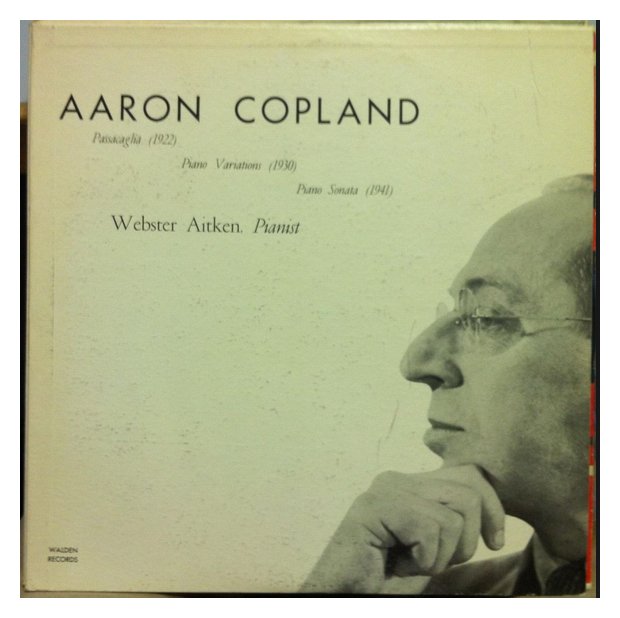 Later Years
Later YearsAitken seems never have allied himself permanently with any institution, preferring the route of ‘visiting artist,’ a position he assumed at the School of Music, University of Illinois at Urbana-Champaign during the years 1961/62. In 1950 he had given programs devoted to late Beethoven at Harvard University and at the Frick Collection in New York, a series he would reprise at Urbana-Champaign. His pupils include Prof. Eric Dalheim (Accompanying, University of Illinois, Urbana-Champaign – retired), pianist and composer Thomas Turner (Prof. of Piano, University of North Carolina – retired), and pianist Carol Rosenberger. Subsequently, Aitken – then only 54 – largely withdrew from public life, turning inward towards a sort of serene existentialism lived out in New York City, Hollywood, and Santa Fe, time reputedly given over to studies of Bach, with occasional forays into Stockhausen and Boulez. He died in Santa Fe, New Mexico May 11, 1981. The Man Tall and lean, his frame often draped in a black leather jacket, Aitken cut a striking figure, both in appearance and personality, with wry iconoclastic implications. His musical tastes ran wide, from Bach to Szymanowski, as did his interest in other arts, Aitken cultivating an expert’s knowledge of baroque architecture and modern painting. He was an accomplished linguist, highly proficient in French, German, Italian, and Greek, and his passion for literature remained life-long. Aitken took great delight in the culinary arts, whipping up feasts worthy of any gourmet. The present author has had access to select excerpts from his writings, and they all display a marvelously cultured and extraordinarily vivid command of the language. It is hoped his Berlin Diary will be published online at Bandoneon’s website. Concert Repertoire A pianist of eclectic tastes, his programs often juxtaposed the old with the new (e.g. Handel with Webern), featured a recurrent mix of Bach, Mozart, Beethoven, or Schubert, and yet often made room for the music of living composers. Late Beethoven remained a life-long study, and musically, his spiritual center. He was playing Bach’s Goldberg Variations and Schubert’s Piano Sonatas long before WW II. And he was a potent advocate of contemporary music, playing Ravel’s Gaspard de la Nuit during the composer’s lifetime, as well as premiering works by such modern American masters as Ives, Copland, Thomson, Menotti, Fuleihan, and Carter. At Town Hall, he programmed Debussy’s Études as early as 1942, and Messiaen’s Fantasie Burlesque in 1946. His concerto repertoire does not seem to have gone much beyond Mozart and Beethoven, the Schubert-Liszt Wanderer Fantasy and Weber’s Concertstuck Op. 79 his furthest excursions from the classical style. A full listing can be found on Bandoneon’s website. Recordings Aitken’s recording career was even briefer than his performing career, beginning with 78 rpm sets for Gamut (Mozart’s Fantasy in C minor K. 475 – available for audition on Bandoneon’s website – and Schubert’s Piano Sonata in G Major D. 894) and extending only to the earliest years of the new LP era. For EMS he taped Schubert’s D. 845, 850, 894, 958, 959, and 960, and for Lyrichord a superb Copland album, which includes quite the finest Piano Sonata on record. Near the end of his life, Delos restored his name to the catalog with two LP releases drawing upon his U. of I. recitals. Preserved therein are riveting ‘live’ performances of Beethoven’s Diabelli Variations, Handel’s Six Grand Fugues, Webern’s Variations, et al. An intriguing document is the 1939 broadcast of Mozart’s Piano Concerto No. 15 K. 450 with Barzin and the NOA, preserved in the Rodgers & Hammerstein Archives of Recorded Sound in New York (only Mvts II and III survive). In private archives exist the 1941 Mozart K. 595 with Walter and the New York Philharmonic, as well as Beethoven’s Les Adieux Sonata and Fauré’s Theme and Variations Op. 73, both from a 1940 Frick Collection recital. An exhaustive search of Europe’s radio archives proved fruitless. |
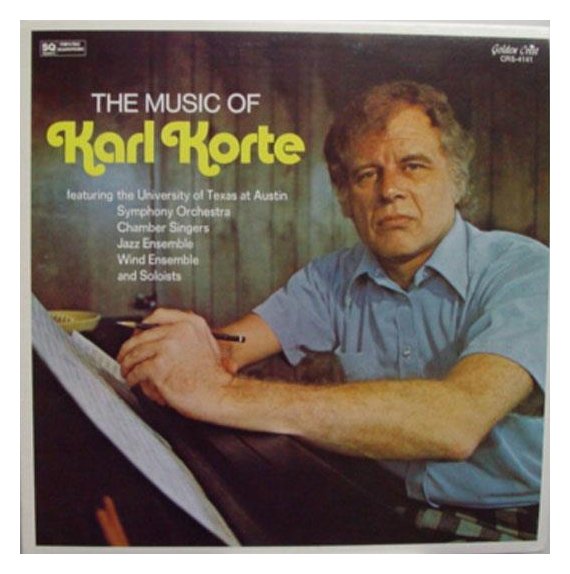
Karl Korte (b. Ossining, New York, August 25, 1928) is an American composer of contemporary classical music. He grew up in Englewood, New Jersey. He attended the Juilliard School, where he studied with Peter Mennin, William Bergsma, and Vincent Persichetti. He later studied composition with Otto Luening, Goffredo Petrassi, and Aaron Copland. Korte taught at the University of Texas at Austin from 1971 to 1997 and currently holds the rank of emeritus professor. From 1997 to 2000 he was a visiting professor at Williams College in Williamstown, Massachusetts. He lives in Cambridge, New York. He has received many national and international awards for his work including two Guggenheim Fellowships (1959 and 1970), Fulbright Awards to Italy and to New Zealand, and a Gold Medal from the Belgian Government in the Queen Elisabeth Music Competition. |
© 1987 Bruce Duffie
This conversation was recorded on the telephone on March 29, 1987. Portions were broadcast on WNIB the following year, and again in 1993 and 1998. This transcription was made in 2017, and posted on this website at that time. My thanks to British soprano Una Barry for her help in preparing this website presentation.
To see a full list (with links) of interviews which have been transcribed and posted on this website, click here. To read my thoughts on editing these interviews for print, as well as a few other interesting observations, click here.
Award - winning broadcaster Bruce Duffie was with WNIB, Classical 97 in Chicago from 1975 until its final moment as a classical station in February of 2001. His interviews have also appeared in various magazines and journals since 1980, and he now continues his broadcast series on WNUR-FM, as well as on Contemporary Classical Internet Radio.
You are invited to visit his website for more information about his work, including selected transcripts of other interviews, plus a full list of his guests. He would also like to call your attention to the photos and information about his grandfather, who was a pioneer in the automotive field more than a century ago. You may also send him E-Mail with comments, questions and suggestions.